|
Due to a greater proximity to patients, colloquial terms with their vagueness have been deliberately left in many places, e.g. "breast cancer" instead of "breast CA". The ICPC-3 diagnosis codes,which were specified, and their explanations can be found here: https://browser.icpc-3.info/, or in an overview at a glance, clearly displayed in color here: https://flyer.icpc-3.info. The specified ICD-10 are linked to the corresponding page of the BfArm: https://klassifikationen.bfarm.de/icd-10-gm/kode-suche/htmlgm2025/index.htm (ICD-10-GM Version 2025 German) or https://icd.who.int/browse10 (ICD-10 Version 2019 English). We are constantly updating corrections and welcome error messages or suggestions for improving the proposed diagnosis codes. |
Consulting concerns
Which consulting issues are common in your practice?

|
Psychosocial crisis counseling |
75% (75,44%) |
|
Questions about lifestyle |
74% (73,91%) |
|
Health prophylaxis |
57% (57,03%) |
|
Nutrition and diet |
50% (50,12%) |
In most cases, these patient concerns are contextual and individually time intensive.
Psychosocial crisis counseling
[ICPC-3 ZC01-ZC99; ICD-10 see below]
Psychosocial crisis counseling includes all possible stresses caused by particular life conditions and is included in ICPC-3 under "ZC - Social problems influencing health status". More commonly encountered are:
- ZC01 Partner relationship problem [ICD-10 Z63, ICD-10 T74.0 + T74.3]
- ZC02 Child relationship problem [ICD-10 Z63, ICD-10 T74.0 + T74.3]
- ZC03 Parent or family member relationship problem [ICD-10 Z63, ICD-10 T74.0 + T74.3]
- ZC09 Other specified relationship problem, e.g., relationship problems with friends [ICD-10 Z63, ICD-10 T74.0 + T74.3]
- ZC10 Loss or death of partner problem [ICD-10 Z63]
- ZC11 Loss or death of child problem [ICD-10 Z63]
- ZC12 Loss or death of parent or family member problem [ICD-10 Z63]
- ZC13 Problems associated with finances [ICD-10 Z59]
- ZC16 Work problem [ICD-10 Z56 + Z57]
- ZC25 Illness of partner problem [ICD-10 Z63]
- ZC26 Illness of child problem [ICD-10 Z63]
- ZC27 Illness of parents or family member problem [ICD-10 Z63]
- ZC30 Partner's behaviour problem [ICD-10 Z63]
- ZC31 Parent or family behaviour problem [ICD-10 Z63]
- ZC90 Concern or fear of having a social problem [ICD-10 Z59 - Z60]
- ZC99 Other specified social problems influencing health status, e.g., social disadvantage including isolation and loneliness [ICD-10 Z60]
Processing limitations and prescriptions of a disease can be found in ICPC-3 PS21 under the heading "Own illness problem" [ICD-10 Z75].
In ICD-10-GM version 2025, the code Z63 - “Other occasions of contact with reference to the immediate family” is not further differentiated. The use of ICPC-3, for example, is useful for differentiation here, as the reasons for contact are further differentiated here.
Questions about lifestyle
[ICPC-3 PS22; ICD-10 Z72.-] Lifestyle issues are usually linked to life situations and are classified in ICPC-3 as "Phase of life problem" PS22.
Preventive health care
[ICPC-3 AP45 Persons seeking health services for other advice and medical consultation; / ICD-10 Z71, ICD-10 Z73 Problems related to difficulties in coping with life]
ICPC-3 AP45 relates to health prevention. This includes everything that promotes well-being and quality of life, and helps to avoid states of exhaustion (burnout symptoms, etc.). In addition, the following questions often arise in the consultation:
- on the individual development of children
- on biorhythmics and regeneration, especially sleep disorders
- on the avoidance of diseases
- the sense of preventive medical checkups
- suspected complications and harmful effects of medical treatments.
Questions about healthy nutrition, change of eating habits and fasting, what should be eaten or administered and how, or why these were asked separately, are of great importance. All of these fall under the classification in ICPC-3 TS04 "Feeding problem of infant or child" and TS05 "Nutrition problems/questions in the adult" [ICD-10 Z71].
Vaccination advice
[ICPC-3 AP45 Persons seeking health care services for other advice and medical consultation; ICD-10 Z71 Persons seeking health care services for other advice or medical consultation, not elsewhere classified]

Vaccination consultations are apparently not an urgent topic of health prophylaxis consultations from the homeopathic point of view[i]. Slightly more than half of all HP homeopaths (52%) do vaccination consultations only rarely (46%) or not at all (6%), although especially the proportion of children in the total collective in classical homeopathic practice is rather high overall. The leading treatment concern in children is "non-specific infections" with 87% (see evaluation "Pediatrics").
As was recorded in a comprehensive survey of homeopathic physicians about 20 years ago, homeopaths as representatives of individual medicine are critical of vaccinations, especially with regard to certain vaccinations and the rigid vaccination timing as a guideline recommendation. Most of them are rather in favor of an individual vaccination decision, but by no means categorically reject vaccinations [4].
From the homeopathic holistic understanding of disease, targeted immunizations are basically a homeopathic concept: a disease-causing agent is applied attenuated modulated as a single impulse to provoke a comprehensive reaction of the vaccinated, which leads to increasing robustness as a result of an active confrontation (initial reaction to the vaccine).
From an individual medical point of view, the criticism is therefore aimed rather at another aspect: it is doubted that, irrespective of the disease and its pathogens, stable herd immunity can be uniformly achieved by mass vaccination programs, because for many diseases and their vaccinations there is a lack of sufficient evidence for their protective efficacy [5].Moreover, such an approach must largely disregard the individual health situation at the time of mass vaccination. Also, it is safe to verify whether the current vaccination programs actually lead to better health in children or may unintentionally have the opposite effect [6].
[i] The result seems surprising against the background of media criticism of homeopathy, since primarily homeopathic practitioners are assumed to have a strict or even missionary anti-vaccination attitude. If this were the case, vaccination counseling would have to be given a much higher priority, since it would be proactively introduced for health prophylaxis.
Other general medical consultation concerns
[ICPC-3 AP45 Persons seeking health care services for other advice and medical consultation; ICD-10 Z71 Persons seeking health care services for other advice or medical consultation, not elsewhere classified]
ICPC-3 has a separate chapter - A1 “Visits for general examinations, routine examinations, family planning, prevention and other visits”, divided into the respective counseling concerns, see: https://flyer.icpc-3.info/
- Attestation concerns
- Occupational medicine consultation
- Cure consulting
- Coordination of treatment reports and expert opinions
These concerns occur only in individual cases and are therefore not listed separately.
Rehabilitation counselling
[ICPC-3 AP45 Persons seeking health care services for other advice and medical consultation; ICD-10 Z71 Persons seeking health care services for other advice or medical consultation, not elsewhere classified]

A special position takes the rehab consultation, which is also addressed in the HP-homeopathy practice more often (37%). This concerns mostly patients, who are accompanying already longer in hom?opathischer treatment and report on the Reha process, as well as further parallel to it in hom?opathischer treatment to be want. Almost two thirds of the patients (63%) do not seek advice from homeopathic practitioners (here HP).
General complaints
In the case of non-specific general complaints, these are typically diagnoses of exclusion. The initial situation in practice is as follows:
The patients concerned have usually already gone through a doctor's odyssey and undergone various therapies without any real relief. Many have tried various antidepressants over long periods of time without comprehensive improvement of their complaints. Now they "want to give it a try, on the recommendation of acquaintances who have found it helpful."
Common General Treatment Concerns - The Top 5
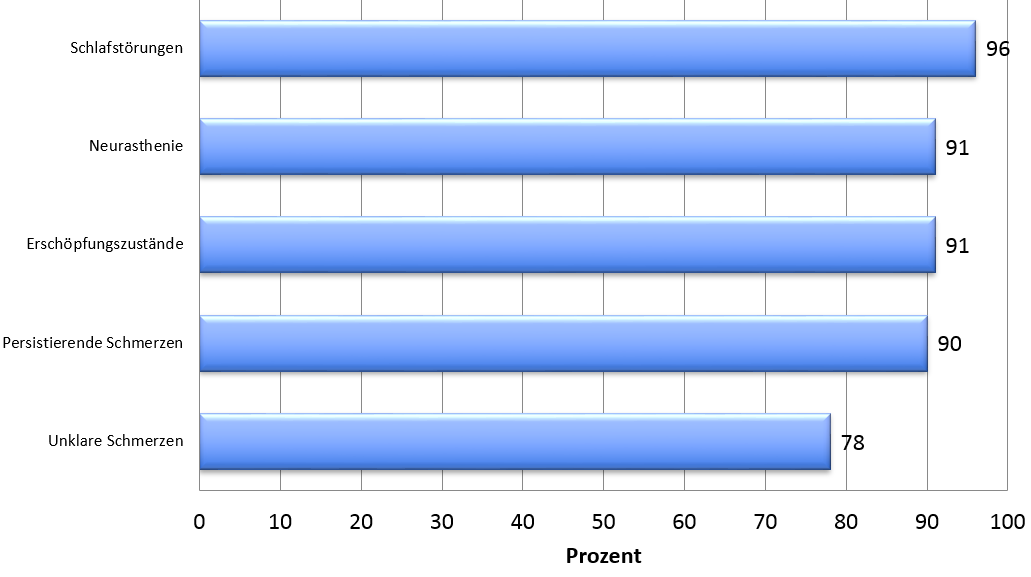
|
Sleep disorders |
96% (95,6%) |
|
Neurasthenia |
91% (91,3%) |
|
Fatigue states |
91% (91,3%) |
|
Persistent pain |
90% (90%) |
|
Unclear pain |
78% (78,3%) |
Sleep disorders
[ICPC-3 PS06 Sleep disorder; ICD-10 F51.- Non-organic sleep disorders, G47.- Sleep disorders]
Sleep disorders are defined as disorders, with a quantitative and qualitative deficiency, that extend over a prolonged period of time and significantly affect daytime activity through fatigue and impaired concentration.
Neurasthenia
[ICPC-3 PD11 Burn-out; ICD-10 F48.0 Neurasthenia]
Neurasthenia refers to an increased susceptibility to fatigue with unpleasant sensations, poor concentration, and a decrease in performance. Accompanied by weakness after mental and physical exertion, as well as the inability to relax, sometimes also with diffuse myofascial pain, uncharacteristic dizziness and general insecurity. An organic cause cannot be determined. It is therefore a purely descriptive diagnosis.
Fatigue states
[ICPC-3 AS04 General weakness or tiredness; ICPC-3 AS05 Postviral fatigue; ICD-10 G93.3 Chronic fatigue syndrome, ICD-10 R53 Malaise and fatigue]
Exhaustion states tend to refer to endured prolonged psychosocial stress or weakness after infections or more severe illnesses without adequate recuperative capacity. Therefore, there is no separate key in ICD-10.
Persistent and ongoing pain
[ICPC-3 AS01, LS18 Chronic widespread pain - CWP; ICD-10 F45.41 Chronic pain disorder with somatic and psychological factors]
Persistent and ongoing pain is referred to when pain occurs in more than three regions of the body and cannot be assigned to a clear diagnosis.
The descriptive diagnosis remains without clear general medical or specialist findings. Patients are often "psychiatrized" in the course of their symptoms. A partial response to amitriptyline and other tricyclic antidepressants fixes the patients in this track.
Unclear pain
[ICPC-3 AS01 General pain at multiple sites; ICD- 10 R52.- Pain, not elsewhere classified, R52.0 - Acute pain, unspecified, R52.1 - Chronic pain, unspecified, R52.9 - Pain, unspecified]
Common general causes of treatment

|
Uncharacteristic fever reactions |
60% (59,89%) |
|
Difficult to adjust blood pressure |
57% (57,28%) |
|
Weight regulation |
50% (50,38%) |
|
Hyperhidrosis |
48% |
|
Functional heart sensations |
42% (42,19%) |
|
Varicose veins (varicosis) |
40% (39,89%) |
|
Anemia signs |
37% (36,82%) |
Uncharacteristic fever
[ICPC-3 AS03; ICD-10 R50.8]
Uncharacteristic fever is a typical concern in paediatric treatment, but also occurs in adults in the context of viral upper / (lower) respiratory tract infections or other contexts. The differential diagnosis of fever of unknown origin (FUO) is complex.
Difficult to adjust blood pressure
[Fluctuation in blood pressure despite medication: ICPC-3 KS51 Elevated blood pressure; ICD-10 I10.9- Essential hypertension, unspecified. For hypertensive crisis, see also Emergency management.
Medication with risk of increased blood pressure: ICPC-3 AD41 Adverse drug reactions; ICD-10 I10 - Essential (primary) hypertension (with increased blood pressure due to medication)].
In practice, typical treatment concerns are those in which patients already receiving blood pressure medication and showing only unsatisfactory or highly fluctuating results want to "do something extra" to improve their health. In addition, there are patients who develop hypertensive crises (diastolic > 120 mm HG) despite conventional medication.
In addition to patients with metabolic derailments and obesity, persistent anxiety-stress reactions due to occupational and private factors are very common, without the presence of organic heart or kidney disease.
Medication with risk of blood pressure increase
- Abuse of non-steroidal anti-inflammatory drugs (backache and headache!)
- Anticonceptives in young women
- Pseudo-epidrine (flu medication)
- Systemic use of cortisone
- Immunosuppressants (cyclosporin A and tacrolimus in transplantation)
- Parallel nasal spray abusus (xylomethazoline and others)
- Methylphenidate
- MAO inhibitors
Disturbed weight regulation with weight gain
[ICPC-3 TS51 Overweight/ BMI over 30 and ICPC-3 TD66 Obesity/ BMI 25-30; ICD-10 E66.0 to E66.99 unspecified]
Disturbed weight regulation is a frequent treatment concern in practice. In addition to complex psychological correlations (loss compensation, disturbed sense of satiety, body schema disorders, traumatic experiences of violence), latent insulin resistance (diabetes II) must always be examined as well.
Hyperhidrosis
[ICPC-3 AS10; ICD-10 R61.9]
Hyperhidrosis refers to excessive sweating of unclear etiology, after ruling out common physical correlates (menopause, hyperthyroidism, latent infections). Important to consider with:
Cholinergics, nicotine, salicylic acid, and alcohol abuse, as well as rare neurologic disorders and vasoactive tumors in localized sweats. Isolated night sweats, on the other hand, are often associated with systemic diseases, especially chronic pulmonary diseases.
Heart Sensations
[ICPC-3 KS01 to KS03; ICD 10 R07.2, R09.8, R00.0 to R00.2, R00.8] Pain in the cardiac region, tremors & pressure, pulsations and irregular heartbeat: these complaints are grouped under cardiac sensations (ICPC-3 KS01 to KS03).
Concerned patients come with extrasystoles (ES) and heart palpitations who have sought medical advice and diagnostics several times without success to "rule out something bad" - with no relief of symptoms. Cardiological findings usually did not show any groundbreaking help, but should be considered in any case, if there are indications of unclear arrhythmias (ventricular eytrasystoles (VES), seizure-like tachycardia, AV-block!).
Varicose veins (Varicosis)
[ICPC-3 KD79.- Varicose veins; ICD-10 I83.- Varicose veins of the lower extremities, ICD-10 I83.- Varicose veins of other localisations]
For complaints in pregnancy: [ICPC-3 WD99 Other specified and unspecified diagnoses and diseases or health conditions in pregnancy, labour and delivery, WD99.03 Haemorrhoids in pregnancy, WD99.04 Varicose veins in pregnancy;ICD-.10 O22.- Venous diseases and haemorrhoids as complications of pregnancy]
Anemia signs
[Iron deficiency: ICPC-3 BD66, ICD-10 D50; B-12 deficiency: ICPC-3 BD67; ICD-10 D51,D52; Other causes: ICPC-3 BD77, ICD-10 D50-D53 (Other) Alimentary anaemias. ICD-10 D55-D59 Haemolytic anaemia. ICD-10 D60-D64 Aplastic and other anaemias]
Latent anemia is found quite frequently as a complaint in patients in homeopathic practices and affects different populations (growth, competitive athletes, pregnancy and lactation period, increased blood loss during menstruation, chronic gastric diseases and other serious diseases, especially malignant tumor diseases).
Since HP homeopaths rarely perform their own laboratory services (also for cost reasons for self-paying patients), these are findings that are requested and brought along, or are delegated or arranged in the case of clinical abnormalities.
The following presents a classification of anemia, organized by its underlying cause. It should be noted that some types of anemia can occur due to multiple causes simultaneously. For example, in chronic kidney disease, both a reduced production of erythropoietin (a hormone that stimulates the production of red blood cells) and iron deficiency can occur. Therefore, a precise diagnosis is necessary in each case to enable appropriate treatment. (Source of the classification: AMBOSS GmbH - Wissen - Anämie - Ätiologie, cited on May 8, 2023)
1) Decreased hemoglobin synthesis:
-
Iron deficiency anemia:
This is by far the most common form of anemia. Common causes include insufficient nutrient intake during the growth phase due to malnutrition or malabsorption, dietary errors such as unbalanced diets, or losses due to chronic blood loss, which often goes unnoticed. -
Anemia of chronic disease (ACD), e.g., chronic kidney disease, cancer, rheumatoid arthritis:
This is considered the second most common cause of anemia. It involves impaired iron utilization and reduced red blood cell production in chronic diseases such as tumors and inflammatory conditions (e.g., infections or autoimmune diseases). This can lead to anemia, which can be either normocytic or microcytic. -
Sideroblastic anemia
-
Thalassemia
-
Hemoglobinopathies
2) Anemia due to reduced cell production:
There are various causes for reduced blood cell production. Anemias due to reduced cell production include:
- Renal anemia
- Myelodysplastic syndrome
- Aplastic anemia
- Megaloblastic anemia
The causes of aplastic anemia can be congenital (due to genetic defects) or acquired, with the latter often being due to radiation therapy, chemotherapy, or less commonly, poisoning.
Megaloblastic anemia occurs due to folate or vitamin B12 deficiency, as these nutrients are essential for cell division. A deficiency can lead to impaired cell division that may affect all cell lines (pancytopenia). Folate deficiency develops more rapidly, as the body's stores last for only about 3 months without further intake, while the body’s vitamin B12 stores can cover the need for 2-3 years. Diagnosis of megaloblastic anemia is based on increased MCV and MCH values (macrocytic, hyperchromic), decreased reticulocyte counts, increased iron levels, and erythropoietic hyperplasia in the bone marrow.
3) Anaemia due to increased breakdown of red blood cells:
-
Hemolytic anemia (hereditary, immunological, infectious, drug-induced)
-
Sickle cell anemia
- Thrombotic thrombocytopenic purpura
4) Other causes of anemia:
- Blood loss, possible causes:
- Acute bleeding
- Chronic bleeding (such as chronic gastrointestinal bleeding or menstrual bleeding)
- Hematological malignancies (leukemia, lymphoma)
Musculoskeletal system
Treatment concerns musculoskeletal system

|
Lumbago / Lumbalgia |
84% (83,88%) |
|
Cervical spine syndrome |
76% (76,47%) |
|
Shoulder-arm syndrome |
69% |
|
Knee complaints, chronic |
67% |
|
Myalgia |
57% (56,77%) |
|
Shoulder stiffness / Periarthritis humeroscapularis (PHS) |
48% (47,57%) |
|
Hip stiffness |
35% |
[Pain classification by localisation according to ICPC-3 with ICD-10 comparison if applicable] :
- ICPC-3 LS01 - Neck symptom or complaint (ICD-10 M54.0, M54.2)
- ICPC-3 LS02 - Back symptom or complaint (ICD-10 M54.0, M54.6, M54.8, M54.9)
- ICPC-3 LS03 - Low back symptom or complaint (ICD-10 M53.3 Coccygodynia; M54.- Back pain with:M54.3 Ischialgia; M54.4 Lumboischialgia; M54.5 Low back pain)
- ICPC-3 LS07 - Shoulder symptom or complaint (ICD-10 depending on cause)
- ICPC-3 LS08 - Arm symptom or complaint (ICD-10 depending on cause)
- ICPC-3 LS12 - Hip symptom or complaint (ICD-10 depending on cause)
- ICPC-3 LS14 - Knee symptom or complaint (ICD-10 depending on cause)
- ICPC-3 LS17 - Muscle pain/ myalgias (ICD-10:
- ICD-10 M60.- Myositis, depending on localisation
- ICD-10 M60.9 - Myositis, unspecified depending on localisation
- ICD-10 M79.1 - Myalgie, depending on localisation
- ICD-10 M79.6 - Pain in the extremities, depending on localisation localisation)
- ICPC-3 LD65 Cervical Spine Syndrome (ICD-10 M54.2:Cervical Neuralgia, M54.12 Radiculopathy: cervical region)
- ICPC-3 LD66 - Back syndrome without radiating pain (ICD-10 M54.-)
- ICPC-3 LD67 - Back syndrome with radiating pain (ICD-10 Code depending on localisation)
- ICPC-3 LD68 - Shoulder syndrome; (ICD-10 M53.1)]
(DD "Persistent and Ongoing Pain" and "Unclear Pain" as mentioned above).
Lumbago / Lumbalgia
[ICPC-3 LS03 - Low back symptom or complaint (ICD-10 M53.3 Coccygodynia; M54.- Back pain with:M54.3 Ischialgia; M54.4 Lumboischialgia; M54.5 Low back pain); ICPC-3 LD66 - Back syndrome without radiating pain (ICD-10 M54.-); ICPC-3 LD67 - Back syndrome with radiating pain (ICD-10 M51.1) Lumbar and other intervertebral disc disorders with radiculopathy)]
"Back pain" accounts for a significant proportion of work disability certificates and is therefore a socially significant problem. "Lumbago" is the diagnostic term for acute onset low back pain in the lumbar spine (LS), and "lumbalgia" is the term used for chronic low back pain.
The majority of patients present with pre-existing conditions and persistent complaints and movement/mobility limitations. These are very often functional disorders with extremely complex, usually not only biomechanical correlations (psychosomatic aspect).
Cervical spine syndrome
[ICPC-3 LS01 - Neck symptom or complaint (ICD-10 M54.0, M54.2); ICPC-3 LS02 - Back symptom or complaint (ICD-10 M54.0, M54.6, M54.8, M54.9); ICPC-3 LD65 Cervical Spine Syndrome (ICD-10 M54.2:Cervical Neuralgia, M54.12 Radiculopathy: cervical region (incl. cervical spine-shoulder syndrome, neck-shoulder-arm syndrome, shoulder-arm syndrome, etc.)]
In the majority of all cases, typ. 25-50 years, a somatoform disorder is found as the basis for the "stiff neck", especially in stressful situations.
Shoulder-Arm Pain
[ICPC-3 LS07 - Shoulder symptom or complaint (ICD-10 depending on cause); ICPC-3 LS08 - Arm symptom or complaint (ICD-10 depending on cause); ICPC-3 LD68 - Shoulder syndrome; (ICD-10 M53.1)]
The majority of cases of shoulder arm pain will have acute or chronic recurrent rotator cuff strain of the respective painful shoulder (Painful Arc). The main prognostic factor is the severity of a frozen shoulder with limited abduction (ABD) and external rotation (AR). Mild sports injuries of the AC joint, impingement syndrome with poor posture, and muscle injuries of the subcapularis muscle, which are often overlooked, should be distinguished from this. In contrast, radicular symptomatology C4-C5 with manifestation in the shoulder is extremely rare.
Knee pain
[ICPC-3 LS14 - Knee symptom or complaint (ICD-10 depending on cause)]
The majority of all cases of knee pain in general practice involve anterior knee pain syndrome with retropatellar rubbing, irritation of the patellar tendon, sometimes also load-dependent bursa irritation, due to a muscular imbalance: shortening of the flexor and extensor muscles with active trigger points. An anatomically functional examination can save a lot of trouble and expense here. One should always look at both knees in comparison. A gait analysis is helpful to locate the center of gravity correctly.
Muscle pain (myalgias)
[ICPC-3 LS17 - Muscle pain/ myalgias (ICD-10: ICD-10 M60.- Myositis, depending on localisation, ICD-10 M60.9 - Myositis, unspecified depending on localisation, ICD-10 M79.1 - Myalgie, depending on localisation, ICD-10 M79.6 - Pain in the extremities, depending on localisation localisation)]
Myalgias also include diagnostically unclear terms such as fibromyalgia or rheumatic pain, as well as calf/foot muscle cramps without a specific diagnosis.
Differential addition to calf pain/ -cramps
The majority of all calf cramps and pain are caused by muscular imbalances with active trigger points in the gastrocnemius and soleus muscles, and possibly also in the popliteus muscle. One-sided incorrect stresses in everyday working life, such as shortening due to long periods of sitting, unsuitable footwear and changes in the foot (splay foot, bent foot, flat foot). In addition, there are somatoform disorders, such as a permanent "pushing against a persistent threat" in everyday life experience.
Hip pain
[ICPC-3 LS12 - Hip symptom or complaint (ICD-10 depending on cause)]
The characteristics of hip osteoarthritis with stabbing groin pain under load and capsular pattern (restricted internal rotation (IR) with hard end sensation), extension deficit and weakness of the abductors with shortened loading phase in the stance leg phase (gait test!) and typical start-up pain are easy to verify clinically.
The majority of patients in middle and progressive age speak of hip pain and mean either the pelvic ring or irritation symptoms at and around the greater trochanter (bursitis subtrochanterica) - important: have the pain region shown!
Hip pain in children has a different context (see below).
Orthopedic traumatology in homeopathic practice
Injuries caused by injuries are rarely represented in the acute consultation in the HP homeopathy practice and when they are, they are mostly post-treatments in individual cases.
The most common knee and ankle injuries are already below the threshold of significance, others are still much rarer and therefore have not been further targeted.
| frequently | occasionally |
never |
|
| (Consequences of) ankle injuries |
26% (25,83%) |
60% (60,16%) |
14% |
| Acute internal knee damage |
15% (15,34%) |
60% (60,1%) |
25% |
Ankle injuries and ankle swelling

Occurrence of ankle injuries in practice.
[Common injuries: Distortion of the ankle joint / Sprain or strain of ankle (ICPC-3 LD46; ICD-10 S93.4)]
The most common cause is supination trauma ("twisting of the foot" inwards in everyday life or during sports. As a result, the talo-fibular ligamentous apparatus is torn (local swelling with limping). In more severe injuries, partial complete tears with capsular injury occur (whole ankle thick, occurrence rarely possible); in the case of previous damage with instability, peroneal tendon luxation may also be present.
In the absence of a traumatic history and if both ankle regions are affected, the differential diagnosis becomes quite complex:
Knee joint injuries
[Injury to multiple structures of knee (ICPC-3 LD45) in ICD-10 Distortion of the knee joint (ICD-10 S83.6) and internal knee injury (ICD-10 M23.9)]

Severe trauma usually does not find itself in the outpatient practice, but immediately in the emergency surgery. In individual cases, there is more likely to be individualized co-treatment of the healing process at the request of the patient. In outpatient practice, anterior knee pain syndrome with lesions of extra-articular structures dominates. Internal injuries are limited to meniscus entrapments and cruciate ligament distortions.
Supplementary differential diagnosis for multiple joint pain
Digestive complaints
[Distension and flatulence with pain (ICPC-3 DS08; ICD-10 R14), Dyspepsia, the stomach upset with pain in the upper abdomen (ICPC-3 DS07; ICD-10 K30) are the two most common concerns, followed by constipation (ICPC-3 DS12; ICD-10 K59.0), irritable bowel syndrome (ICPC-3 DD78 Colon irritable; ICD-10 K58.9), and uncharacteristic diarrhea (ICPC-3 DS11; ICD-10 K52.9)]
Common complaints of the digestive system

|
Evaluation |
Frequent |
|
Flatulence, belching |
84% (84,14%) |
|
Dyspepsia |
81,5% |
|
Constipation, chronic |
78% |
|
Constipation, chronic |
76% (76,21%) |
|
Unclear diarrhea |
59% (58,56%) |
|
Hemorrhoids |
55% (55,49%) |
|
Bile duct problems |
31% (31,14%) |
Due to the fear of "stomach and intestinal cancer", most patients who come with persistent complaints of the digestive system have already undergone one or more mirror examinations, antibiosis (in the case of Helicobacter eradication) and the most diverse dietary and naturopathic concepts for the regulation of bowel movements, sometimes also an accompanying psychotherapy. Frequent are above all diets with gluten and milk protein avoidance, even if there is no clearly clarified connection.
However, the complaints come back, persist with variations and are experienced as limiting the quality of life and performance. These include:
Flatulence, belching
[ICPC-3 DS08 Flatulence, Gas Accumulations, and Belching; ICD-10 R14 - Flatulence and Related Conditions (including Belching, Bloated Abdomen, Flatulence, Meteorism)]
Persistent and distressing flatulence as the only symptom, occurring independently of diet and sometimes combined with stool irregularity, is part of somatoform complaint complexes in the majority of cases.
Dyspepsia
[ICPC-3 DS07; ICD-10 K30]
Symptomatic manifestations include: pre- and postprandial tension, early feeling of fullness, pressure to the point of a lump or stone in the upper abdomen, intermittent pain.
Constipation
[ICPC-3 DS12, ICD 10 K59.0]
Since 20% of all German citizens and about 75% of them women suffer from constipation [4], it is a very common complaint that is mostly treated by self-medication and dietary approaches. Conventional medicine is limited to high-fiber dietary supplements and laxatives. Naturopathic medicine offers various preparations to normalize the intestinal flora.
The search for causes of mucosal irritation and their interrelationships is overemphasized. Motility disorders due to dysregulation of the enteric nervous system, as well as vegetative stress components result in a complex event, which often does not fit into a usual diagnosis.
In the end, the "irritable colon" remains as a descriptive diagnosis of exclusion, without changing the therapeutic concepts.
Irritable bowel syndrome
[ICPC-3 DD78 Irritable bowel syndrome; ICD 10 K58.1]
Exclusion diagnosis with typical symptoms and lack of pathological findings (e.g. exclusion of lactose intolerance, gluten intolerance or chronic inflammatory bowel disease)
Patients primarily tend to pursue food intolerances as the cause and experiment with them. However, omission diets often only provide temporary relief. Patients are quick to speak of diarrhoea when they either have mushy stools without any abnormalities or the frequency of stools is unusually high. It is therefore necessary to enquire precisely about the condition and the accompanying symptoms.
Unclear diarrhea
[ICPC-3 DS11 Diarrhea; ICD-10 K59.1 Functional Diarrhea, A09.- Other and Unspecified Gastroenteritis and Colitis of Infectious and Unspecified Origin]
Thin stools, also known as diarrhea, only become diarrhea when there are more than 5 bowel movements per day and the stool volume is significantly higher than usual (>250g/d). A high stool frequency with only low volume and "airy spurting flakes" is usually indicative of irritable colon syndrome, especially if there are also periods of constipation in the history.
Patients primarily tend to pursue food intolerances as the cause and experiment with them. However, omission diets often provide only temporary relief. Patients are quick to speak of diarrhea when either mushy stools are present without abnormality or stool frequency is unusually increased. It is therefore necessary to ask about the condition and accompanying symptoms in detail.
Haemorrhoids
[ICPC-3 DD84 Haemorrhoids; ICD-10 K64.- If in pregnancy and puerperium, see there: ICPC-3 WD99.03 Haemorrhoids in pregnancy; ICD 10 O22.1 in pregnancy, ICD 10 O87.1 in puerperium]
Bile duct disorders
[Complex of complaints according to ICPC-3:
- DS06 - Other specified localised abdominal pain (ICD10 R10.- Abdominal and pelvic pain with R10.1 Upper abdominal pain, R10.4 Other and unspecified abdominal pain)
- DS08 Flatulence, gas accumulation and belching (ICD-10 R14 - Flatulence and related conditions, incl. belching, bloating, flatulence, meteorism)
- DS09 - Nausea (ICD-10 R11 - Nausea and vomiting)
- DS10 - Vomiting (ICD-10 R11 - Nausea and vomiting)
- DS11 - Diarrhoea (ICD-10 K59.1 - Functional diarrhoea, A09.- Other and unspecified gastroenteritis and colitis of infectious and unspecified origin)
- DS18 - Changes in stool and bowel movements (ICD-10 R19.4 - Changes in bowel habits, R19.5 - Other changes in stool)
- DS13 - Jaundice (ICD-10 R17.0)
- DD82 - Cholecystitis or cholelithiasis or both;
- DD82.00 - Cholangitis (ICD-10 K83.0)
- DD82.01 - Cholecystitis (ICD-10 K81.-)
- DD82.02 - Cholelithiasis (gallstones (ICD-10 K80.)]
Acute cholelithiasis with fever is very rare, as patients usually go straight to hospital due to its acute nature.
Inflammatory gastrointestinal diseases
In practice, diverticulosis/itis and acute crises of a known ulcer disease dominate as individual events. Acute cholelithiasis with fever is very rare, as patients typically seek medical attention immediately due to the acute nature of the condition.
| frequently | rarely | never | |
| Diverticulosis |
25% |
58% |
17% |
| Ulcer (stomach, duodenum) |
24% (24,29%) |
62% (62,4%) |
14% |
[Classification according to ICPC-3:
DD79 Chronic enteritis/ ulcerative colitis (ICD-10 K50 Crohn disease [regional enteritis], K51 Ulcerative colitis, K52.0 Other noninfective gastroenteritis and colitis]
DD69 Duodenal ulcer (ICD-10 K26)
DD70 Other specified or unknown peptic ulcer (ICD-10 K25, K27, K28)
DD77 Diverticular disease (ICD-10 K57)]
Diverticulosis
[ICPC-3 DD77 Diverticular disease (ICD-10 K57)]
Since diverticulosis is often asymptomatic or manifested by occasional abdominal cramps emphasized in the left lower abdomen, while flatulence and stool irregularity are usually prominent, the diagnosis is often not equated. Acute diverticulitis is a severe, often febrile painful condition (the appendicitis of the left lower quadrant), which in severe cases is also accompanied by nausea.
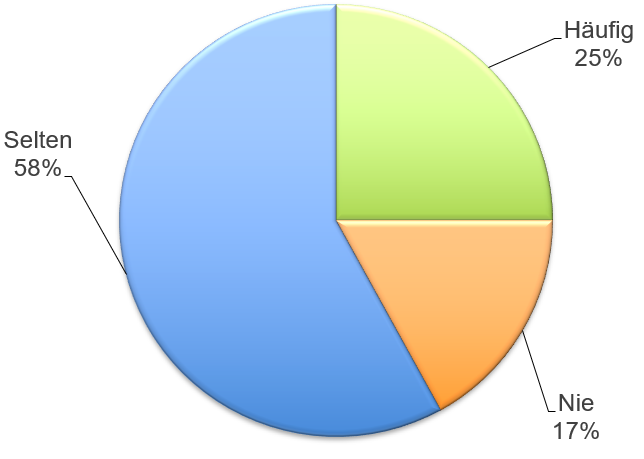
Ulcer disease
[ICPC-3 DD70 Other specified or unknown peptic ulcer (ICD-10 K25, K27, K28)]
Patients suffering from ulcer disease are often treated initially with antibiotics for Campylobacter infection for fear of chronicity and "stomach cancer." In addition, they receive gastric acid blockers. Only if this therapy does not help several times, patients come also times "to the homoeopath" with the reason to take in the long run not only symptomatic therapy with gastric acid blockers, without that the "thing is gone to the reason".
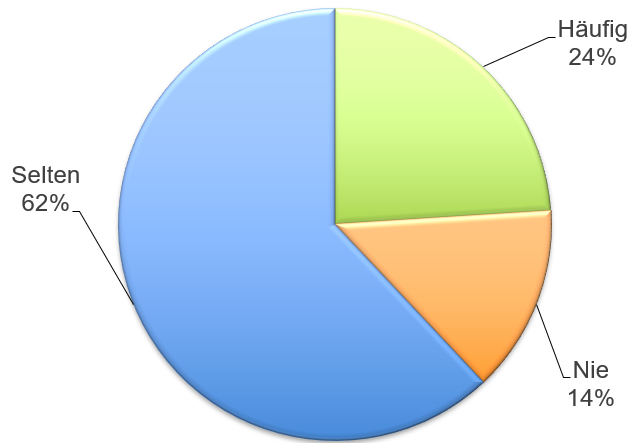
Abdominal pain in adults
[Classifkation according to ICPC-3: DS01 Generalized Abdominal Pain; DS02 Epigastric Pain; DS06 Other Locally Specific Pain; no exact corresponding class in ICD-10, Upper Abdominal Pain localized ICD-10 R10.1]
Abdominal pain in children
[Classifkation according to ICPC-3: DS01 Generalized Abdominal Pain; DS02 Epigastric Pain; DS06 Other Locally Specific Pain; no exact corresponding class in ICD-10, Upper Abdominal Pain localized ICD-10 R10.1]
Postoperative digestive disorders
[Specific symptoms according to ICPC-3 and/or DD99 Other specified or unknown diagnoses or diseases of the digestive system, AD42 Complication of medical treatment; ICD-10 K91.- Diseases of the digestive system after medical procedures, not elsewhere classified]
These take a special role in the outpatient HP-homeopathy practice, because they mostly concern patients who are already under treatment and wish a homeopathic accompaniment in this phase. Therefore, occasional mentions dominate. Only 20% of the interviewed colleagues treat postoperative digestive disorders more frequently.

| frequently | rarely | never | |
|
Postoperative digestive disorders |
20% (20,46%) |
64% (64,19%) |
16% |
Skin / Allergy and itching
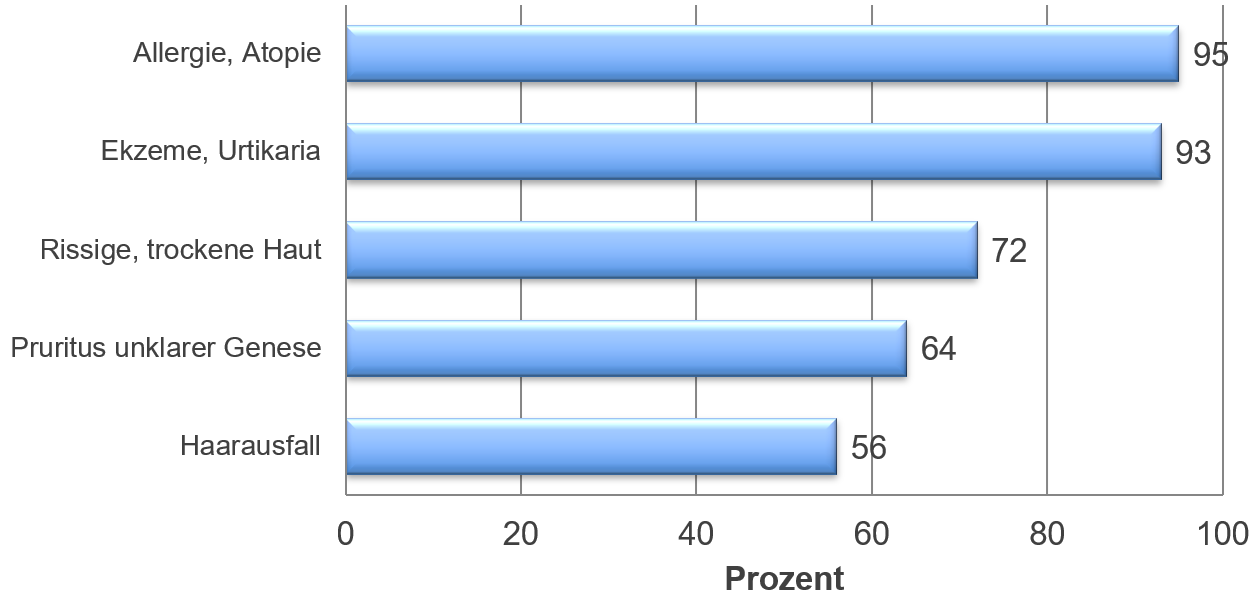
| Evaluation | Frequent |
|
Allergy, atopy |
95% (95,39%) |
|
Eczema, urticaria |
93% (92,83%) |
|
Cracked dry skin |
72% (71,86%) |
|
Pruritus of unknown origin |
64% (63,99%) |
|
Hair loss |
56% (56,26%) |
Atopy and atopic dermatitis
With over 90%, atopy and neurodermatitis [ICPC-3 SD69, ICD-10 L20.8] are the most common concerns in homeopathic practice. The fact that this topic is quite complex shows that at least the immune system and the nervous system are involved as fundamental regulatory circuits.
This also applies to uncharacteristic complaints such as persistent dry skin and rhagades in hyperkeratotic skin areas [ICPC-3 SS08; ICD-10 L30.8] as well as pruritus [ICPC-3 SS02; ICD-10 L29.9 Pruritus, unspecified].
Unclear pruritus
[ICPC-3 SS02; ICD-10 L29.9 Pruritus, unspecified]
In the case of "unclear pruritus", according to current case figures, scabies [7] should be increasingly considered as a differential diagnosis of eczema, in addition to the atypical appearance of psoriasis.
Systemically more frequent are latent diabetes, iron deficiency anemia, latent uremia, liver dysfunction and myeloproliferative diseases (e.g. chronic lymphocytic leukemia in old age) as well as adverse drug reactions.
Itching due to drug ingestion - more common in practice
[ICPC-3 SS02; ICPC-3 AD41 Adverse Drug Reactions; ICD-10 L29.8 Other pruritus]
- Antibiotics (e.g., penicillins, cephalosporins, sulfonamides, nitrofurantoin)
- Anticonvulsants (e.g., carbamazepine, mesuximide, phenytoin)
- Analgesics/rheumatic drugs (e.g., acetylsalicylic acid (ASA), ibuprofen)
- Antihypertensive agents such as ACE inhibitors (e.g. captopril)
- Local anesthetics in ointments
- X-ray contrast media
Hair loss
[ICPC-3 SS10; ICD-10 L65.9]
may have hormonal (androgenic alopecia, hypoparathyroidism) and psychological components (alopecia areata, totalis) in addition to seborrhea, tinea capitis, and contact allergies.
Infectious inflammatory skin diseases

| Evaluation | Frequent |
|
Warts |
80% (chronic, recurrent) |
|
Herpes simplex, rec. |
71% (70,58%) |
|
Aphtae |
63% (62,91%) |
|
Skin nail mycoses |
46% (45,78%) |
|
Boils, folliculitis |
25% (Compare rarely: 64% / 64.19%) |
Treated in these skin / mucous membrane symptoms from a classical homeopathic point of view is the immunogenic regulation, in other words the susceptibility to the disease itself and thus the occurrence of recurrences.
[Classification: Warts or molluscum contagiosum (ICPC-3 SD02; ICD-10 B08.1), Herpes simplex (ICPC-3 SD04; ICD-10 B00.9), aphthae (ICPC-3 DD66.02; ICD-10 K12.0), Boil or carbuncle (ICPC-3 SD06.00; ICD-10 L02.9), Skin and nail mycoses / Dermatophytosis (ICPC-3 SD08; ICD-10 B35.1 - Tinea unguium, ICD-10 B36.9 Superficial mycosis, unspecified)]
Nail anomalies
[ICPC-3 SS09 Symptom or complaint of the nails; ICD-10 L60.- Diseases of the nails, ICD-10 Q84.6 Other congenital malformations of the nails]
Specific diseases with skin manifestations

| Disease | Frequent | Rare |
|
Psoriasis |
48% (48,33%) |
47% |
|
Acne |
42% (42,45%) |
52% (52,17%) |
|
Rosacea |
31% (30,69%) |
60% (59,59%) |
[Classification: Psoriasis (ICPC-3 SD72; ICD-10 L40.-), Acne (ICPC-3 SD76; ICD-10 L70.-), Rosacea (ICPC-3 SD81; ICD-10 L71.-)]
Other
Other mentions: Wound healing disorders, vitiligo, styes, actinic keratosis. These are also individual cases and are treated concomitantly with homeopathic remedies to improve immune regulation.
Eye diseases
Since only the anterior segments of the eye can be diagnostically evaluated in general practice, all other eye diseases including refractive errors are always co-treatments with an already existing diagnosis.
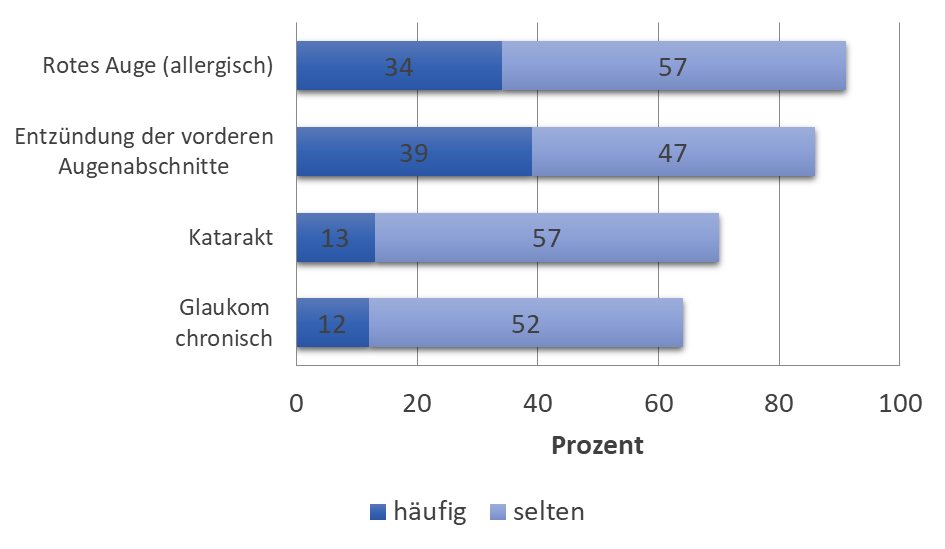
The evaluation shows: the frequency of inflammation anterior segment of the eye, red allergic eye, cataract, glaucoma (together 98%). All other eye diseases account for 2% in homeopathic practices.
There is no eye disease or disease of the eye, which is significantly often treated in homeopathic practice as a single diagnosis.
| Evaluation |
Frequently |
Rarely |
| Inflammation of the anterior segments of the eye |
39% (39,38%) |
47% (46,54%) |
| Red eye (allergic) |
34% (33,75%) |
57% |
| Cataract |
13% (12,78%) |
57% (57,28%) |
| Glaucoma, chronic |
12% (11,76%) |
52% (52,17%) |
Inflammation of the anterior segments of the eye
The differential diagnosis of acute infectious conjunctivitis [ICPC-3 FD01; ICD-10 H10.0, H10.8 B30.9] must be differentiated from allergic irritation [ICPC-3 FD65; ICD-10 H10.1], as the IfSG may need to be observed here.
The same applies to a herpes infection of the cornea and viral keratitis [ICPC-3 FD05; ICD-10 H16.0], which can lead to ulcerations with corneal damage. Due to the painful nature of the condition, patients usually refer themselves directly to an ophthalmologist.
Red eye
The most common "red eye" in practice is allergic conjunctivitis with known atopy (diagnosis codes see above). In children, bacterial inflammation with very sticky eyes is also common.
Because of the risk of infection, there are restrictions on visiting community facilities IfSG §34.
Chronic courses and susceptibilities of the red eye are also found in the homeopathy consultation, usually when several therapeutic approaches have not led to success, especially to avoid recurrences.
Cataract and glaucoma
Cataracts [ICPC-3 FD70; ICD-10 H28] and glaucoma [ICPC-3 FD71; ICD-10 H40-H42] are slightly more common but not significantly so.
Lens opacification (cataract) is a typical incidental finding of constitutional homeopathic treatment. Incipient cases can be partially influenced in the course of treatment. An opthalmological control of the severity in the course is necessary.
Glaucoma - apart from congenital defects of the aqueous humor outflow - has been the subject of psychosomatic research since the 1950s. Consistently, agitation and mixed images of an anxious depressive basic attitude have been observed [8]. The susceptibility to crises is therefore amenable to homeopathic co-treatment.
Increasing visual impairment
[ICPC-3 FS05 Decreased vision; see ICD-10 Visual impairment and blindness (H53-H54): H53.1 Subjective visual impairment, H53.9 Visual impairment, unspecified, H54.9 Unspecified visual impairment (binocular)]
Other eye diseases
Visual defects, poor vision, strabismus are isolated cases in the practice. Mostly, patients come because of other ailments and may want to have these ailments indirectly treated as well. This is especially true for children with visual defects, which can also improve under constitutional homeopathic treatment.
Keratoconus, retinal detachment and macular degeneration are diagnoses that must be thought of in order to forward them to specialist diagnosis based on symptoms that occur.
Pediatrics
Paediatrics: The Top 5
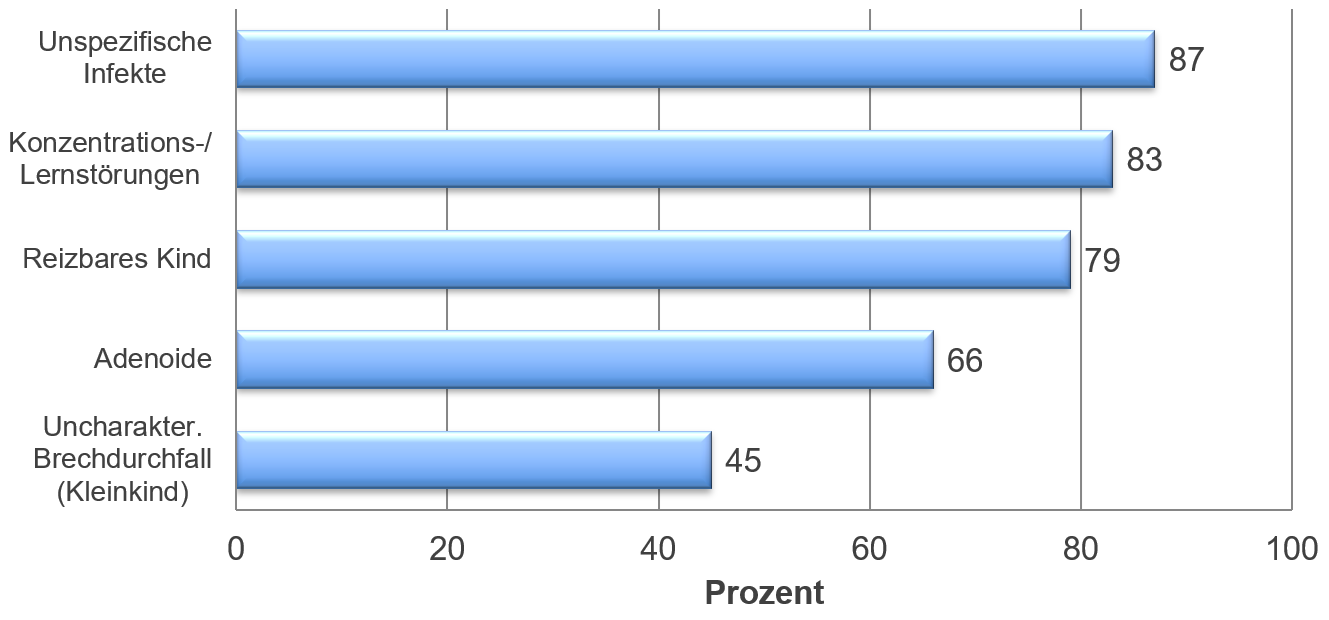
|
Non-specific infections |
87% (86,95%) |
|
Concentration and learning disorders |
83% (82,86%) |
|
Irritable infant |
79% (78,77%) |
|
Adenoids |
66% (65,72%) |
|
Uncharacteristic diarrhea with vomiting (infant) |
45% (44,75%) |
|
Characteristic diarrhea with vomiting (infant) |
45% (44,75%) |
Non-specific respiratory infections
Since nonspecific infections of the upper and lower respiratory tract in children often occur in a mixed picture, these have been asked for together and thus take the highest rank in total. Differential diagnosis can be differentiated:
Upper respiratory tract: Acute upper respiratory tract infection [ICPC-3 RD02; ICD-10 J06.-], also with fever [ICPC-3 AS03; ICD-10 R50]
This also includes acute nasal congestion [ICPC-3 RS09; ICD-10 J00], tonsillitis & pharyngitis [ICPC-3 RD04; ICD-10 J03; ICD-10 J02], croupy cough [ICPC-3 RD05; ICD-10 J05], tracheitis [ICPC-3 RD06; ICD-10 J04], uncharacteristic cough [ICPC-3 RS07; ICD-10 R05].
If there is a suspicion of acute whooping cough [ICPC-3 RD01; ICD-10 A37], the corresponding regulations of the IfSG are relevant (IfSG §6, §34, §24 IfSG)
Lower respiratory tract: Acute bronchitis and bronchiolitis [ICPC-3 RD06; ICD-10 J20, J21], all forms of pneumonia [ICPC-3 RD09; ICD-10 J18]
Mononucleosis [ICPC-3 AD04; ICD-10 B27] and scarlet fever [ICPC-3 AD24.09; ICD-10 A38], which is more common in young children, are more frequently relevant in the differential diagnosis (also note: IfSG §34, §24 IfSG).
Concentration and learning disorders
Concentration and learning disorders with attention deficit disorder are manifested in children by:
- rapid lack of persistence,
- a tendency to move from one activity to another without completing one,
- and disorganized poorly regulated behavior with restlessness of movement.
[Classification according to ICPC-3:
- PD16 Attention deficit hyperactivity disorder
- PS17 Memory or attention problem
- PS18 Child behaviour symptom or complaint
- PS20 Specific learning problems
ICD-10: ICD-10 F81.- Circumscribed developmental disorders of school skills, ICD-10 F90.- Hyperkinetic disorders, F98.80 Attention deficit disorder without hyperactivity with onset in childhood and adolescence]
Irritable child
Irritable infant [ICPC-3 AS12; ICD-10 R68.1] presents with excessive crying, restlessness, and frequent angry reactions. This excludes teething problems or infantile colic.
Irritability in adolescents and adults involves perceived internal tensions with anger and rage that influence behavior without a defined mental disorder. The affected parents are disturbed and seek professional help. [ICPC-3 PS04 Feeling or being irritable or angry;ICD-10 R45.- Symptoms related to mood: R45.1 Restlessness and agitation, R45.4 Irritability and anger, R45.5 Hostility, R45.6 Physical violence]
Adenoids
Hypertrophy of the palatine and pharyngeal tonsils (adenoids) [ICPC-3 RD66; ICD-10 J35.1-J35.3] (see also Acute Otitis) is the common presentation in childhood of an incomplete immune response with a high tendency to recur, which may recur even after drainage surgery.
Uncharacteristic diarrhea with vomiting
Vomiting in combination with diarrhoea without pathogen diagnosis, of non-infectious etiology: [Single syst: ICPC-3 DS10 - vomiting, ICPC-3 DS11 - diarrhoea; ICD-10 K52.9 Non-infectious gastroenteritis and colitis, unspecified]
The majority of cases remain without pathogen diagnosis and are only hospitalised if there is a risk of exsiccosis with indications of electrolyte imbalance [ICPC-3 TS09; ICD-10 E86], dehydration and electrolyte imbalance [ICPC-3 TD99; ICD-10 E87].
Characteristic diarrhea with vomiting
Infectious gastroenteritis: [ICPC-3 DD05; ICD-10 A09]
According to IfSG §6 / §7 , there are reporting obligations for indications of salmonella (paratyphoid and typhoid), cholera vibrio, schigella, EHEC and norovirus infections.
Note
Nonspecific lymphadenopathy [ICPC-3 BD02 - Other specified or unknown lymphadenitis; ICD-10 I88 Unspecified lymphadenitis], although common in practice, is rarely the primary treatment concern.
|
Lymphadenitis, postinfectious |
frequent 16% (16,34%) |
Other developmental abnormalities

|
frequent |
rare | |
|
Enuresis |
66% (66,49%) |
26% |
|
Developmental delays, unspecified |
57% (56,77%) |
35% (35,29%) |
|
Tic disorders |
42% (42,19%) |
44% (44,21%) |
|
Failure to thrive in infants |
39% (38,87%) |
48% (48,33%) |
|
Speech and language development disorders |
35% (35.29%) |
51% (50,89%) |
|
Eating disorders |
31% (31,45%) |
57% |
|
Premature birth, consequences of |
23% |
55% (55,49%) |
|
Encopresis |
13% (12,78%) |
60% (60,1%) |
Enuresis
Enuresis [ICPC-3 PS10 Bedwetting or enuresis; ICD-10 F98.0-] is a typical maturational problem in young children which is particularly difficult to classify. Organic causes of urinary incontinence [ICPC-3 US03 - Urinary incontinence; ICD-10 N39.0 - Urinary incontinence, unspecified] should be ruled out if symptoms persist.
Developmental delays and developmental abnormalities
The developmental delays are described in ICD-10 as developmental disorders F80-F89. An exact equivalent in ICPC-3 exists only in part, or they are grouped under behavioural disorders in children PS18, behavioural disorders in adolescence PS19, specific learning problems PS20 without further differentiation or summarised under other mental disorders PD99 (for profound developmental disorders ICD-10 F84, other ICD-10 F88 and unspecified ICD-10 F89).
In practice, developmental abnormalities usually show a mixed picture of motor performance deficits, behavioural abnormalities, neurological soft signs, such as persistent residual reactions of early childhood reflexes, as well as a slower average age of development, without a specific diagnosis being found.
Tic disorders
[ICPC-3 NS11 Speech problem; ND99.03 Tic disorder; ICD-10 F95.- Tic disorders] including stuttering and stammering
Failure to thrive
Growth disturbance [ICPC-3 TS08 Growth delay; ICD-10 R62.- Failure of expected normal physiological development with: R62.0 Delayed attainment of developmental milestones, R62.8 Other failure to achieve expected physiological development, R62.9 Failure to achieve expected physiological development, unspecified].
Feeding problems in infants [ICPC-3 TS04 Feeding problems in infants or children; ICD-10 F98.2 - Feeding disorder in early childhood].
Speech and language development disorders
[ICPC-3 PS20 all forms of circumscribed learning disorders; ICD-10 F80.0- Circumscribed developmental disorders of speech and language]
The diagnosis refers to impaired speech and language development that occurs in childhood and is related to central nervous system (CNS) maturation processes when the problems persist over time and do not resolve on their own.
Eating disorders
Eating disorders [ICPC-3 PD17; ICD-10 F50.- with F50.0- anorexia nervosa and F50.2 bulimia] are characterised by disturbances in body image perception, identity crises during puberty with deliberately induced weight loss and/or self-induced binge eating. In children, eating disorders can already be noticeable through abnormal eating behaviour [ICPC-3 PS09 Eating problems in children; ICD-10 F50.-].
Other development-related concerns
Premature birth, consequences of summarizes all problems of too early gestational age with deficiency states. Infants are hospitalized and may benefit from concomitant homeopathic treatment. [ICPC-3 AD65 Preterm neonate; ICD-10 P07.- Disorders associated with short gestation and low birth weight, not elsewhere classified]
Encopresis [ICPC-3 PS11; ICD-10 F98.1] involves repeated shedding of normally formed feces in the pants or in inappropriate places, which is considered abnormal in relation to the child's age. Constipation or sphincter dysfunction are not present.
"Syndromic children," children with autism, mutism, infantile cerebral palsy (ICP) - are not statistically recorded because of purely individual mentions (see also Other Neurological Disorders).
Ear, Nose and Throat medicine (ENT)
ENT complaints - The Top 5

|
frequently |
rarely |
never |
|
|
Throat infections |
85% (85,16%) |
13% |
2% |
|
Acute otitis |
71% (70,84%) |
21% |
8% |
|
Otalgia |
41% (40,92%) |
43% |
16% |
|
Chronic serous ear infections |
40% (40,4%) |
45% |
15% |
|
Ear canal inflammations |
36% |
52% |
12% |
[Classification of complaints and diseases with diagnosis codes:
- Pharyngitis [ICPC-3 RD02.00; ICD-10 J02]
- Acute tonsillitis [ICPC-3 RD04; ICD-10 J03]
- Otitis media and myringitis [ICPC-3 HD02 Acute otitis media or myringitis (ICD-10 H65.- Non-purulent otitis media, ICD-10 H73.0 Acute myringitis); ICPC-3 HD03 Serous otitis media (ICD-10 H65.0 Acute serous otitis media); ICPC-3 HD05 Chronic otitis media (ICD-10 H65.2 Chronic serous otitis media) ICPC-3 HD05.00 Cholesteatoma (ICD-10 H71 Cholesteatoma of the middle ear) ]
- Otitis externa, ear canal irritation [ICPC-3 HD01; ICD-10 H60.9]
Classification according to symptoms:
- Sore throat [ICPC-3 RS12 Complaints or symptoms of the throat; ICD-10 R07.0 - Sore throat]
- Otalgia (earache) [ICPC-3 HS01; ICD-10 H92.0]
Sore throat
[ICPC-3 RS12 Pharyngeal complaints or symptoms; ICD-10 R07.0 - Sore throat; Pharyngitis (ICPC-3 RD02.00; ICD-10 J02); Acute tonsillitis (ICPC-3 RD04; ICD-10 J03)]
Sore throat refers to any visible redness and swelling of the tonsils and pharyngeal wall with or without visible pus, including pressured regional lymph nodes.
The diagnosis of streptococcal infection of the pharynx is not made until the pathogens are detected. In this case, HP has a treatment restriction for the acute illness according to §24 IfSG. §34 IfSG requires that a medical clearance certificate must be available if the person concerned wishes to enter communal facilities, e.g. children at school.
The risk of infection can be minimized by antibiosis (AB), and the individual course of illness can be shortened by 16 h on average. The susceptibility for throat infections, also with other pathogens, however, is not. There is also no effective prophylaxis against the now rare complications of streptococcal infection by AB [13].
Acute otitis
[ICPC-3 HD02 Acute otitis media or myringitis (ICD-10 H65.- Non-purulent otitis media, ICD-10 H73.0 Acute myringitis); ICPC-3 HD03 Serous otitis media (ICD-10 H65.0 Acute serous otitis media)]
The symptomatology of acute otitis media and myringitis is manifested by the edematous, blistered, or bulging tympanic membrane (TM) with redness and pain, possibly purulent ear discharge with acute perforation.
Otalgia
Otalgia [ICPC-3 HS01; ICD-10 H92.0] refers to ear pain of multiple contexts, such as tubal catarrh, ear canal irritation, after trauma with and without discharge.
Chronic ear infections
[ICPC-3 HD05 chron. Otitis media (ICD-10 H65.2 Chronic serous otitis media)]
Here, there is a visible accumulation of secretions without strong signs of inflammation, absent or blurred tympanic membrane light reflex, retraction and protrusion with hearing complaints, e.g., children with adenoids [not referring to chronic mucosal ulceration with tympanic membrane defect or cholesteatoma which are classified with ICPC-3 HD05 (ICD-10 H71).
Ear canal inflammation
[ICPC-3 HD01 Otitis externa, ear canal irritation; ICD-10 H60.9]
Ear canal inflammation presents symptomatically with desquamation and thickening in the ear canal, eczematous rash, moist gullies or boils, with itching and intermittent pain.
Hearing Disorders
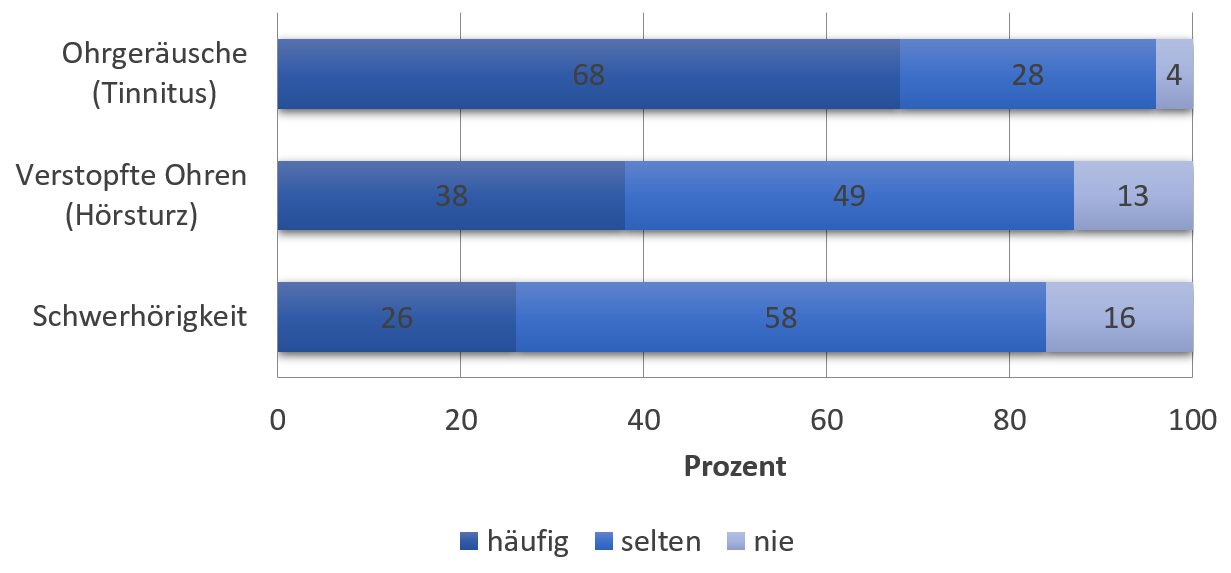
|
frequently |
rarely |
never |
|
|
Noises in the ear (tinnitus) |
68% |
28% |
4% |
|
Blocked ears (sudden hearing loss) |
38% |
49% |
13% |
|
Hearing Impairment |
26% |
58% |
16% |
Tinnitus
[ICPC-3 HS03 all types of ringing in the ears; ICD-10 H93.1 tinnitus aurium; ICD-10 H93.2 other abnormal auditory sensations]
Sudden hearing loss
Sudden hearing loss [ICPC-3 HS02; ICD-10 H91.2] refers to impaired hearing in one ear or hearing loss with or without a sensation of obstruction.
Unilateral sudden hearing loss, occurs within seconds, minutes, or hours, sometimes with tinnitus, without other symptoms. Evidence is a significant drop in the audiometry curve, but different frequencies may be affected (high-low-mid range), and the steep drop can be distinguished from hearing residuals in the normal dB range.
Parameters of the anamnesis
- Accident, blast trauma
- Infectious disease of the upper respiratory tract, as well as herpes infections, toxoplasmosis, measles
- Ototoxic drugs; aminoglycoside antibiotic, loop diuretics, salicylates, cytostatics, rarely after vaccination
- Intoxication: alcohol and nicotine abuse, other drugs
- Pre-existing hearing loss with acute episode
- Psychological stress, post-traumatic stress syndrome (PTSD)
- No idea case (NIC)
Hearing Impairment
Hearing impairment [ICPC-3 HS02; ICD-10 H90] can be classified by age-related hearing loss [ICPC-3 HD68; ICD-10 H91.1], acoustic trauma [ICPC-3 HD35; ICD-10 H83.3], congenital hearing loss, or deafness [ICPC-3 HD69; ICD-10 H90.- Conductive and sensorineural hearing loss]. Hearing loss is usually an incidental finding of patient concerns during case admission and rarely a primary concern for homeopathic treatment.
Other ENT disorders
Sinusitis (see also upper respiratory tract infections). Single mentions: auditory perceptual disorders and hyperacusis.
Auditory Perceptual Disorders
Auditory perceptual disorders [ICD-10 F80.20 Receptive language disorder] are partial developmental abnormalities and may occur peripherally (due to recurrent otitis media or centrally due to brain dysfunction or may also have a genetic basis. They are characterized by:
- reduced ability to remember acoustically conveyed information (sentences, rhymes, songs)
- frequent confusion of sound-similar sounds (phonetic and written language)
- Excessive sensitivity to sound in the presence of normal environmental noise
- reduced speech comprehension in usual environmental noise (classroom, kindergarten)
- reduced attention in the presence of usual environmental noise
- lack of localization of a sound source
A logopedic diagnosis should be initiated as early as possible in order to counteract communicative disorders in a meaningful way.
Hyperacusis
[ICPC-3 HS02 Complaint of hearing; ICD-10 H93.2 Other abnormal auditory perceptions]
Hyperacusis refers to hypersensitivity to annoying sounds with marked avoidance behavior. Inner ear hearing loss, focal epilepsy with acoustic aura, signs of migraine but also drug intolerance occur in as triggers.
In most cases, the hypersensitivity to noise is an expression of a stressful situation, which then manifests itself in this physical "overstimulation" and can be superimposed by anxiety disorder and depression.
Neurology
Neurological complaints: The Top 5
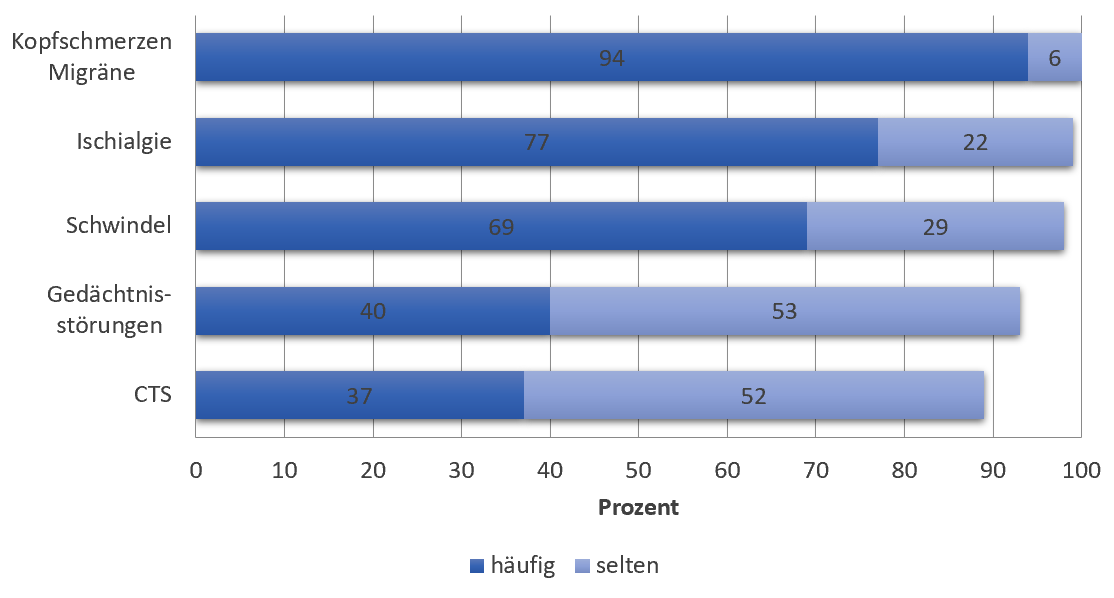
|
frequently |
rarely |
|
|
Headache, migraine |
94% (93,86%) |
6% |
|
Ischialgia |
77% (76,98%) |
22% |
|
Vertigo |
69% (69,3%) |
29% (29,16%) |
|
Memory disorders |
40% (40,15%) |
53% (52,94%) |
|
Carpal tunnel syndrome (CTS) |
37% (36,57%) |
52% (52,17%) |
Headache
Headache (HA) represents one of the most frequent treatment concerns in homeopathic practice. Since the boundaries between different types of headache are often blurred in practice, they were grouped together in the survey.
ICPC-3 includes:
Tension headache [ICPC-3 ND73; ICD-10 G44.2] oppressive generalised, with muscle tension of the neck, with and without pain in the cranial muscles
Vascular HA (migraine) [ICPC-3 ND71; ICD-10 G43.-] with and without aura, unilateral with vomiting, neurological deficits and positive family history
Cluster HA [ICPC-3 ND72; ICD-10 G44.0] with temporal-orbital pain attacks occurring intermittently with lacrimation, nasal congestion possibly with miosis and ptosis of the affected side
Uncharacteristic HA [ICPC-3 NS01; ICD-10 G44.8] also as post-traumatic HA [ICPC-3 NS01,ICD-10 G44.3]
Cervicocephalic HA [ICPC-3 LD65 Cervical spine syndrome; ICD-10 M53.0 Cervicocephalic syndrome] with and without cervical root irritation
Ischialgia
[ICPC-3 LS03 - Symptom or complaint of lower back / low back pain, ICPC-3 LD67 - Back pain with radiation (ICD-10 51.1 Lumbar and other disc disorders with radiculopathy; ICD-10 M53.3Coccygodynia, ICD-10 M54.- Back pain with: M54.3 Ischialgia; M54.4 Lumboischialgia; M54.5 Low back pain)]
Ischialgia refers to back pain with radiating pain, nerve root irritation, including disc herniation. The radiating pain fits a neurogenic pattern of supply and may be accompanied by deficits.
Vertigo
Vertigo is divided into specific vertigo syndromes [ICPC-3 HD67; ICD-10 H81 Disorders of vestibular function], which cover benign positional vertigo, labyrinthitis, Meniere's disease, and vestibulopathy with characteristic spinning vertigo seizures, nystagmus, and violent accompanying vegetative symptoms,
as well as in uncharacteristic vertigo [ICPC-3 NS09; ICD-10 R42 Dizziness and giddiness] with swaying, weakness, blackout, balance fluctuations with staggering sensation, multiple correlations, usually with circulatory dysfunction or anxiety.
Memory disorders
ICPC-3 PS17 includes amnestic disorders, concentration disorders, and disorientation without identifiable organic causes [ICD-10 F06.7]. In practice, this occurs very often in the context of stress disorders.
Carpal tunnel syndrome
[ICPC-3 ND76;ICD-10 G56.0]
Disturbed and reduced sensitivity of fingers I-III in the area supplied by the median nerve, nocturnal aggravation, with radiation and, in severe cases, weakness of the muscles of the ball of the thumb.
Differential diagnosis: arm pain
Other neurological disorders
Not so common in practice
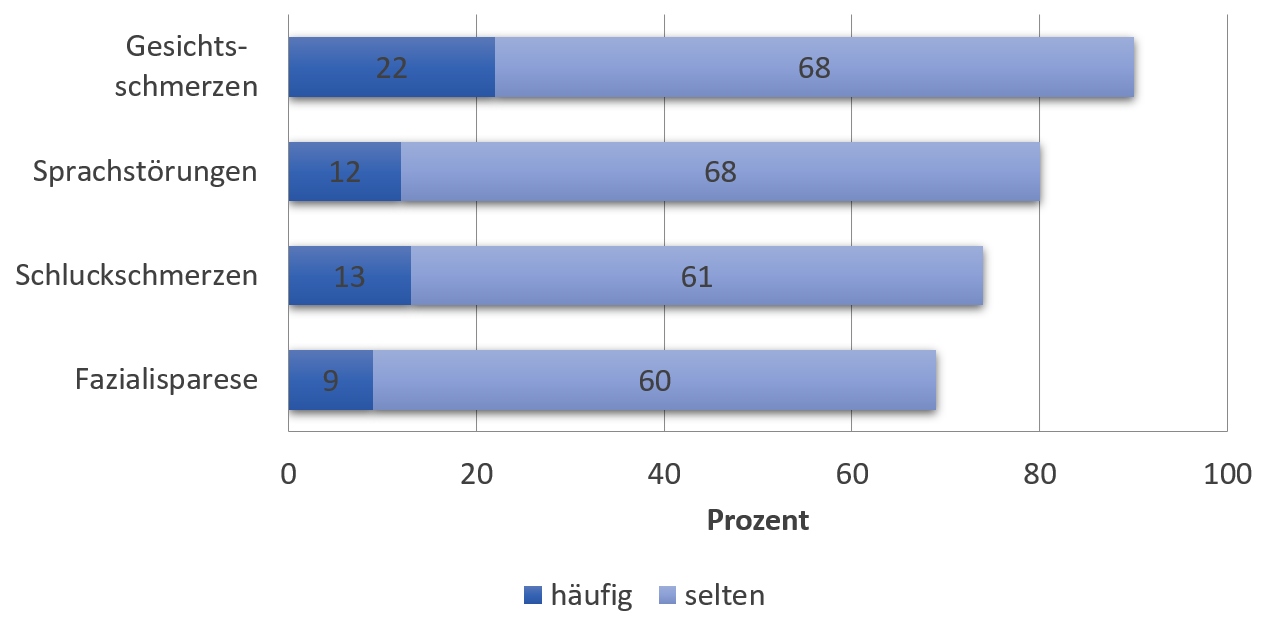
|
frequently |
rarely |
|
|
Facial pain |
22% (21,19%) |
68% (68,28%) |
|
Speech disorders |
12% (11,76%) |
68% |
|
Swallowing disorders |
13% (12,53%) |
61% (61,38%) |
|
Facial paresis |
9% (8,95%) |
60% |
Facial pain
Facial pain can be uncharacteristic and have many different associations, in which case it is classified as ICPC-3 NS02 Pain, facial (ICD-10 R51 Headache). Defined complaints are recorded individually, such as facial migraine under ICPC-3 ND71 (ICD-10 G43.-), trigeminal neuralgia ICPC-3 ND74 (ICD-10 G50.0), sinus pain ICPC-3 RS11 (ICD-10 J01), zoster neuralgia ICPC-3 SD03 (ICD-10 G53.0).
These were summarised in the survey, with atypical migraine being the underlying cause in most cases in general medical practice.
Speech and swallowing disorders
Speech disorders [ICPC-3 NS11; ICD-10 R47,-] include aphasia, dysphasia, dysarthria as well as any type of slurred speech. For the survey, non-organic tic disorders, stuttering [ICPC-3 NS11; ICD-10 F98.5 Stuttering] delayed learning to speak [ICPC-3 PS20; ICD-10 F80.-] were also summarised here as a circumscribed developmental disorder.
Dysphagia, incl. difficulty in swallowing [ICPC-3 D21; ICD-10 R13] includes any type of dysphagia, even with a feeling of choking, regardless of the context.
Facial paresis
Facial paresis [ICPC-3 ND75; ICD-10 G51.0] as an acute unilateral event of peripheral paresis or paralysis is much rarer in practice, but occurs sporadically as a concern, especially as an "idiopathic" peripheral paresis (incomplete eye closure, Bell phenomenon, and lack of frowning on the affected side) due to cold, shock, emotional stress.
Single mentions of neurological diseases
The less frequently occurring neurological disorders show a significant decrease compared to the top 5.
Infantile cerebral palsy (ICP) and traumatic brain injury (TBI) are not included in the general concerns.
Concomitant or follow-up treatment of sequelae, however, is found in only a few practices with specialization and a comprehensive presence of advanced practitioners (see also Accompanying Treatment for Specialist Diagnoses)
Psychic abnormalities
The Top 7

|
frequently |
rarely |
|
|
Anxiety symptoms |
88% (88,32%) |
s: 10% (9,97%) |
|
Depressive symptoms |
88% (87,72%) |
s: 11% (10,74%) |
|
Acute stress reactions |
71% (71,35%) |
s: 25% (24,55%) |
|
Phobias |
61% (60,61%) |
s: 33% (32,73%) |
|
Obsessive-compulsive disorders |
41% (41,43%) |
50% (49,61%) |
|
Post-traumatic stress reaction (PTSD) |
38% (37,85%) |
51% (51,15%) |
|
Difficult puberty |
48% |
44% (43,37%) |
Anxiety and tension states
Anxiety symptoms and depressive moods occupy the largest space in practice among primary mental health concerns, followed by acute stress reactions/life crises.
Anxiety is divided into anxiety and anxiety disorders:
Anxiety [ICPC-3 PS01; ICD-10 F48] with great anxiety and inner tension without manifest mental disorders, which form the largest group in practice,
Anxiety disorder [ICPC-3 PD06; ICD-10 F41] with generalized and persistent anxiety, including severe physical symptoms, which limits life and persists over a long period of time.
Depressive symptoms
Depressive symptoms are distinguished into:
Depressed feeling [ICPC-3 PS03 Feeling sad; ICD-10 F43.2 Adjustment disorders, ICD-10 F32 Depressive Episode] with experience of inadequacy, loneliness, unhappiness, and worry felt as distress without the presence of a mental disorder.
Depressive episode [ICPC-3 PD12 Depressive disorder; ICD-10 F32 Depressive Episode] as an underlying affective disorder with loss of energy, activity, and inability to feel pleasure or muster concentration and interest, accompanied by sleep and appetite disturbances with lowered self-confidence and self-esteem.
Stress reactions
Stress reactions are divided into:
Acute stress reaction [ICPC-3 PS02; ICD-10 F43.0] to an event that requires a significant change in life and a major adjustment that interferes with coping with everyday life and affects the social fabric and, over a limited period of time, significantly affects the internal equilibrium, such as startle reactions, grief, homesickness, loss experiences.
Posttraumatic stress reaction [ICPC-3 PD08; ICD-10 F43.1] Reactions to severe stress, and adjustment disorders] including adjustment disorder, as a prolonged reaction with restlessness and agitation due to reverberations and re-emerging dissociative disorders under stress that permanently limit social relationships and performance.
Phobias and compulsions
[ICPC-3 PD06 Anxiety disorder or anxiety state, PD07 Obsessive-compulsive disorder or related disorders; ICD-10 F40.- Phobic disorders; ICD-10 F42.- Obsessive-compulsive disorder]
Phobias and compulsions are characterized by significant anxiety in well-defined situations that are usually not considered dangerous but are experienced with high distress and are accompanied by marked avoidance behavior.
Difficult puberty
[ICPC-3 PS19 Symptom or complaint of behaviour, in adolescents; ICD-10 F91.- Social behaviour disorder, ICD-10 F92.- Combined social and emotional disorder, ICD-10 F94.- Disorders of social functioning with onset in childhood and adolescence, ICD-10 F98.8- Other specified behavioural or emotional disorder with onset in childhood and adolescence, ICD-10 F98.9 Unspecified behavioural or emotional disorder with onset in childhood and adolescence].
Behavioral disorders in adolescence also difficult puberty is characterized by a mixed picture of disorders of social behavior, attachment competence, affect inhibition possibly with motor restlessness and imbalance, which emerge in late childhood and at the beginning of puberty and, depending on the situation, can also take an unfavorable course.
Other psychic disorders
Single mentions: Personality disorders, relationship disorders, attachment disorders, suicidal ideation.
Acute suicidality
[ICPC-3 PS05 Suicide or attempted suicide; ICD 10 R45.8 Other symptoms and signs involving emotional state]
Acute suicidality should be distinguished. If this becomes evident in a patient, the patient is admitted to inpatient treatment for reasons of due diligence.
Personality disorders and psychoses
Patients with manifest personality and relationship disorders [ICPC-3 PD15; ICD-10 F60.-] are isolated cases and are most likely to play a differential diagnostic role in homeopathic practice.
If, then it is a concomitant treatment. If there are indications of biographical breaks in the life line and if there are indications of a greater degree of ego-instability and if the patient denies previous psychiatric diagnoses, hospitalization or medication, the patient should be referred for psychiatric diagnosis, since this is extensive and complex. Secondary psychotic reactions are also found in epilepsy, transit syndromes in PBI, apoplexy, post-inflammatory, or are drug related.
Respiratory disorders
Frequent respiratory complaints
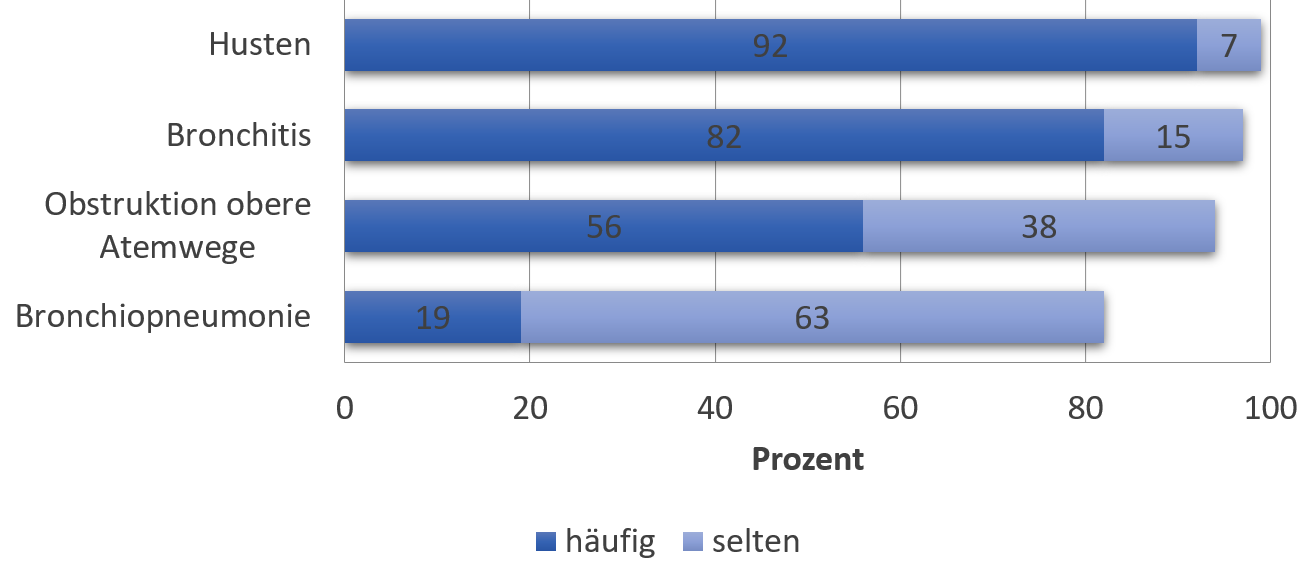
|
frequently |
rarely |
|
|
Cough |
92% |
7% |
|
Bronchitis |
82% (82,35%) |
15% (14.83%) |
|
Upper airway obstruction |
56% |
38% |
|
Bronchiopneumonia |
19% (19,43%) |
63% (62,91%) |
Upper respiratory tract infections
Uncharacteristic infections of the upper respiratory tract are very common in practice, which are primarily characterised by obstructive symptoms of the nose and paranasal sinuses (PNS) and hoarseness. As the boundaries are usually fluid, they were summarised in the survey. A distinction is made between:
Nasal congestion, rhinitis [ICPC-3 RS09; ICD-10 J00 Acute rhinopharyngitis] especially in children, blocked paranasal sinuses (PNS) with unilateral pressure [ICPC-3 R11;ICD-10 J34.8 Other specified diseases of the nose and sinuses] also with diffuse nasopharyngeal symptoms [ICPC-3 RD02; ICD-10 B00.2 Gingivostomatitis herpetica and pharyngotonsillitis herpetica, ICD-10 B08.5 Other viral infections characterised by skin and mucosal lesions, unspecified; ICD-10 J02.8 acute charact. Pharyngitis; ICD-10 J02.9 Pharyngitis, unspecified; ICD-10 J06 Acute infections of multiple or unspecified upper respiratory tract sites]
Manifest purulent sinusitis [ICPC-3 RD03; ICD-10 J01] with unilateral shadowing with illumination, purulent rhinitis, tenderness, palpitations and deep-seated visual pain is less common.
Acute laryngotracheitis [ICPC-3 RD05; ICD-10 J04.2] with hoarseness and stridor and a dry, painful cough is most common in children (pseudocroup).
Cough and respiratory infections of the lower respiratory tract
Cough [ICPC-3 RS07; ICD-10 R05] is one of the most common treatment concerns in all age groups.
It is significant to recognize acute contagious pertussis [ICPC-3 RD01; ICD-10 A37] due to the restrictions of §24 IfSG, because the disease cannot be treated by HP in the phase of contagiousness and severe complications for reasons of inpatient monitoring.
Acute bronchitis [ICPC-3 RD06; ICD-10 J20] presents with cough with fever, chest pain, dry accessory sounds on auscultation, and dyspnea on exertion.
Acute bronchopneumonia [ICPC-3 RD09; ICD-10 J18.0] may present with marked impairment of general condition (GC), night sweats, and evidence of an infiltrate. 19% is probably underreported in the survey because borderline cases to prolonged bronchitis are not easily diagnosed clinically.
Single mentions
Sarcoidosis [ICPC-3 BD99.01; ICD-10 D86] and other respiratory diseases [ICPC-3 RD99; ICD-10 J62 Pneumoconiosis caused by quartz dust, ICD-10 J43 Emphysem, ICD-10 J47 Bronchiectasis] such as silicosis, emphysema, bronchiectasis were only mentioned by a few in the survey as individual cases in the co-treatment (see also "Accompanying treatment for specialist diagnoses").
Endocrine disorders
Common primary endocrine disorders - Top 7
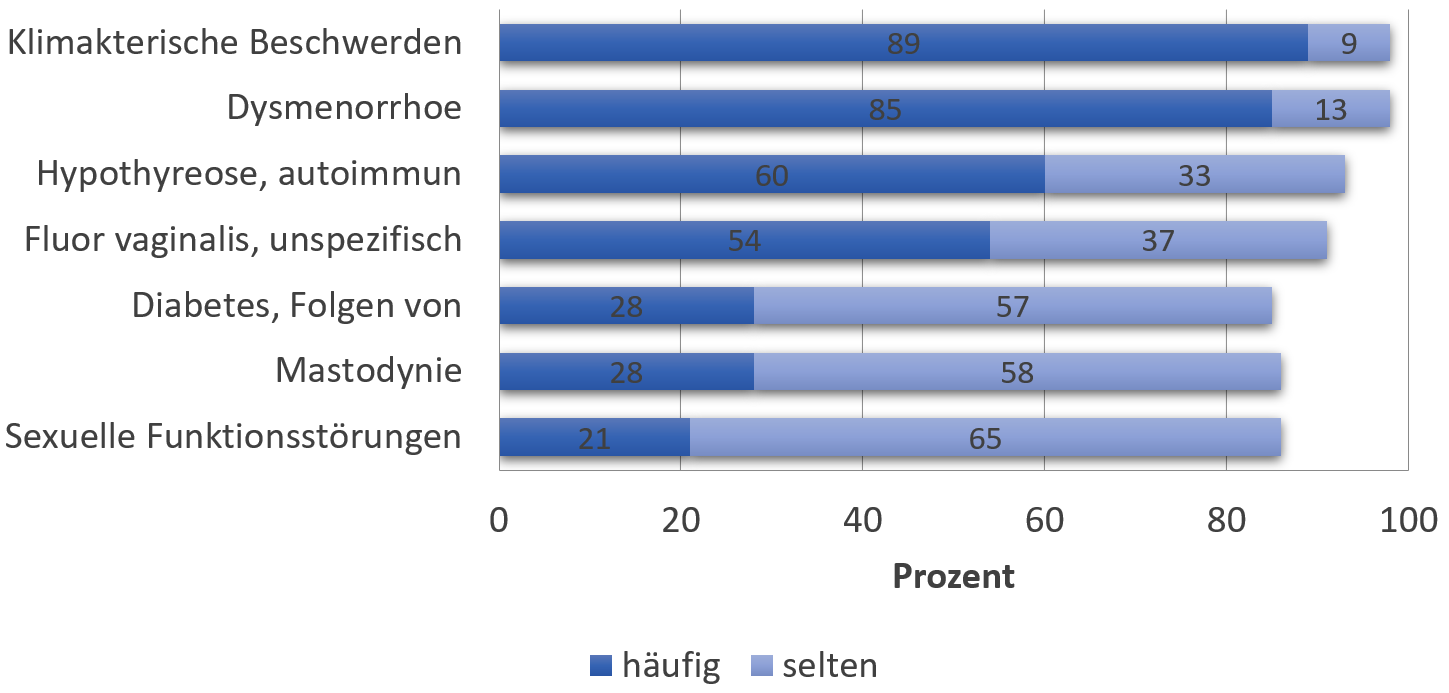
|
frequently |
rarely |
|
|
Menopausal symptoms |
89% |
9% |
|
Dysmenorrhea |
85% (84,65%) |
13% (12,51%) |
|
Hypothyroidism, autoimmune |
60% (60,35%) |
33% (33,24%) |
|
Fluor vaginalis, non-specific |
54% (53,96%) |
37% (36,57%) |
|
Sexual dysfunction |
21% (21,22%) |
65% (65,47%) |
|
Mastodynia |
28% (28,13%) |
58% (57,54%) |
|
Diabetes, consequences of |
28% (28,13%) |
57% (57,28%) |
Climacteric complaints
Climacteric complaints [ICPC-3 GS13; ICD-10 N95], including atrophic colpitis, represent one of the most common concerns in practice: in addition to flushing symptoms, sleep disturbances, mental instability, weight gain, and musculoskeletal pain states (arthralgias, myofacial complaints), they also include fluctuations in blood pressure that are difficult to adjust. The risk of cancer (mammary carcinoma, ovarian carcinoma, cervical carcinoma) is increased in this phase of life, but not obligatory. Climacteric symptoms can last for 10 years or more and are by no means easily remedied with hormone substitution. In addition, there is a persistent disagreement as to whether long-term hormone replacement therapy increases the risk of cancer [10]. This question is most likely to be differentiated in the individual health situation.
Dysmenorrhea
Classification: Dysmenorrhoea [ICPC-3 GS05 Menstrual pain; ICD-10 N94.4 Primary dysmenorrhoea] including menstrual cycle disorders [ICPC-3 GS09; ICD-10 N91-N93]
This treatment concern is among the most common reasons for consultation. In most cases, patients have undergone an odyssey of various diagnoses and treatment attempts. As a rule, it is a constitutional occurrence whose correlations represent an accumulation of the most diverse complexes of complaints. These include diagnosed endometriosis, with and without hormone use, with genetic predisposition, as well as simultaneous psychological stress, ligament and pelvic floor weakness, associated with dysuria and irritable bowel symptoms, and often also a thyroid dysfunction. These highly individualized complexes of complaints are often well amenable to homeopathic treatment, and the quality of life can be decisively improved in many cases.
Hypothyroidism
Hypothyroidism [ICPC-3 TD69; ICD-10 E03] with a high TSH level and low T3, T4 levels is in practice in the vast majority of cases due to autoimmune thyroiditis of the Hashimoto type. Antibody detection for initial diagnosis and thyroid ultrasonography for clarification is necessary.
Thyroid dysfunction in practice is often associated with persistent life stressful conflicts that require psychosomatic analysis. Weakness and restlessness can be improved by obligatory hormone substitution, but are insufficient in many cases requesting additional treatment.
Fluor vaginalis
[ICPC-3 GS16 Vaginal discharge; ICD-10 N89 Other non-inflammatory diseases of the vagina]
Fluor vaginalis, nonspecific leukorrhea without specific acute pathogen serology is also one of the very common concerns, with itching discharge and thereby sometimes significantly impaired general well-being (sexual dysfunction, decreased self-esteem).
Sexual dysfunction
Sexual dysfunction is differentiated into:
Absence of libido [ICPC-3 PS07; ICD-10 F52.0] without evidence of an organic disorder, usually waning interest in sexuality and or decreased genital excitability,
Decreased sexual fulfillment [ICPC-3 PS07; ICD-10 F52.1 -F52.6] with non-organic impotence, erectile dysfunction, ejaculatio praecox, vaginismus, vaginal dryness during intercourse, reflecting inability to have a sexual relationship,
Concern about sexual proclivities [ICPC-3 PS08; ICD-10 F64 to F66], non-organic inability to live in a sexual relationship the self-desired way of sexual needs.
Erectile dysfunction
[ICPC-3 GS24 Impotence or Erectile Dysfunction; ICD-10 F52.0 Sexual Dysfunction Not Caused by an Organic Disorder or Disease, ICD-10 N48.4 Impotence of organic origin]
Due to the extensive differential diagnosis and the frequency in middle-aged men, erectile dysfunction occupies a special position. They are rarely the primary concern, but arise from a confidential conversation during the anamnesis. Since serious conditions may lie behind them, they should be identified or ruled out as specifically as possible during the course of treatment or right at the beginning.
Mastodynia
Mastodynia [ICPC-3 GS04; ICD-10 N64.4] refers to severe breast pain in women, independent of pregnancy and lactation.
Diabetes mellitus, consequences of
Insulin-dependent diabetes [ICPC-3 TD71; ICD-10 E10.-] and non-insulin-dependent diabetes TD72; ICD-10 E11.-] are typical secondary findings of a case admission in homeopathic practice. The aim here is to achieve optimal regulation with improved adjustability, fewer hypoglycemic crises, and delaying late effects, especially nephropathy and retinopathy, through homeopathic adjunctive treatment.
All patients receive specialist care.
Other endocrinological disorders
Single mentions:
Primary amenorrhea is not so common as a treatment concern in practice and is usually a secondary finding of other constitutional treatment concerns.
Sterility & desire for children are, according to the survey results, also only individual cases, when conventional strategies (ICSI) were not successful, or the woman does not tolerate or shies away from a comprehensive hormonal intervention. Homeopathic treatment is often surprisingly successful.
Cases of thyroid adenomas and Graves' disease are usually isolated cases. Patients present with inadequate thyroid therapy, or post- or pre-operative. The overall condition and life stressing situations are usually poorly understood, or given little or no consideration in conventional diagnosis and treatment.
[Classification according to ICPC-3:
- Primary amenorrhoea [ICPC-3 GS07.00; ICD-10 N91.0]
- Sterility & desire to have children [ICPC-3 AF01 Family planning (Procreative management), AF01.00 Desire to have children; no direct equivalent in ICD-10, possibly ICD-10 Z31.3 - Other methods that support fertilisation, ICD-10 Z31.6 - General counselling in connection with fertilisation]
- Cases of thyroid adenoma [ICPC-3 TD26 Benign neoplasm of the thyroid gland; ICD-10 D34] and Graves' disease [ICPC-3 TD65 Goitre, TD68 Hyperthyroidism or thyrotoxicosis; ICD-10 E05.0 Hyperthyroidism with diffuse goitre]
Urology - urinary tract
The four pillars of urinary tract symptoms
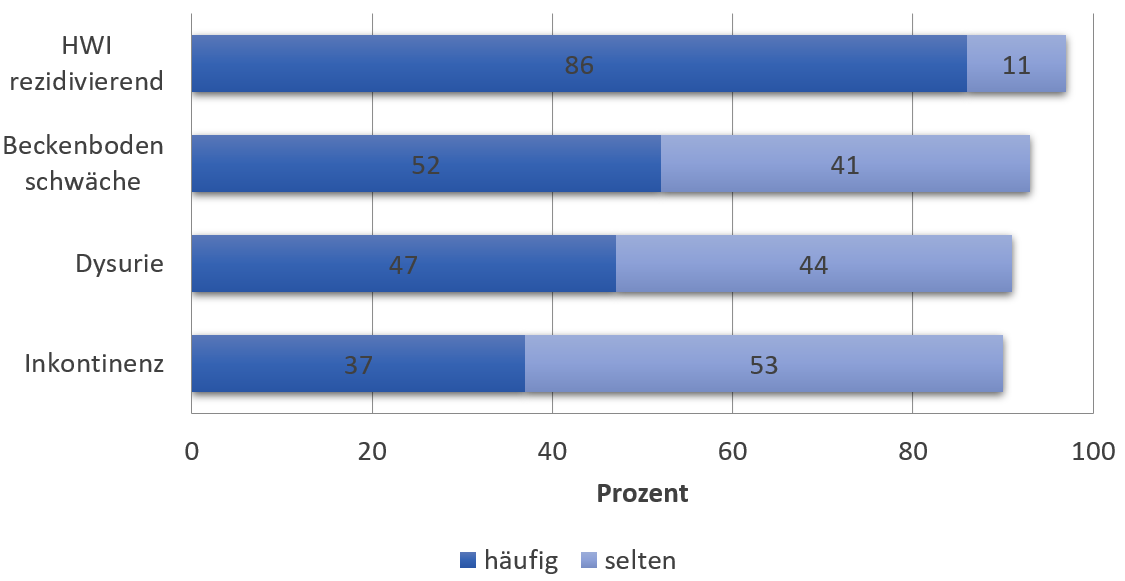
|
frequently |
rarely |
|
|
UTI, recurrent |
86% (86,18%) |
11% |
|
Pelvic floor weakness |
52% (52,17%) |
41% (41,43%) |
|
Dysuria |
47% (47,31%) |
45% (44,75%) |
|
Incontinence |
37% (36,82%) |
53% (52,68%) |
Urinary tract infections
Acute and recurrent urinary tract infections (UTIs) [ICPC-3 UD02; ICD-10 N39.0] (most commonly ascending due to E. coli bacteria) are a very common concern in practice. [ii]
In most cases, recurrent symptoms are found to be pain and urinary urgency, but rarely pathogens or the symptoms keep coming back despite multiple antibiotics. Patients often have had an odyssey of measures at the time of case admission.
[ii] Purulent urethritis (ICPC-3 UD03; ICD-10 N34.-) which requires special pathogen diagnosis (restrictions according to IfSG §24) is not treated acutely in HP practice.
Dysuria
Dysuria [ICPC-3 US01; ICD-10 R30.0] with pain during and after urination without organic or primary infectious cause is very often accompanied by pelvic floor myalgia and internal tension.
Men: Mostly individually different contexts with ostensibly anxious apprehension. Symptomatically, persistent burning after micturition, disturbed urine flow, post-micturition dribbling with residual voiding on movement and nonspecific feeling of pressure in the lower abdomen are found, suggesting a urological differential diagnosis to prostate changes in men [11].
Women: Irritable bladder symptomatology with burning sensation and constant urge to urinate that exists only when awake is found more frequently in compulsively structured self-unconfident female patients, and early childhood ambivalence conflicts between holding on and letting go can be found more frequently [11].
Hematuria
[ICPC-3 US06; ICD-10 R31]
Pelvic floor dysfunction
Frequent pelvic floor dysfunction with painful positional changes, also as a result of multiple births with an unstable pelvis is included in ICPC-3 under WS99 other disorders of the female genital area as pelvic instability [ICD-10 N81.8 Other female genital prolapse].
Incontinence
Incontinence [ICPC-3 US03; ICD-10 N39.3-39.4] with organic associations such as pelvic floor weakness, involuntary urination, or stress-induced urination that is difficult to control.
Enuresis nocturna in children is classified under ICPC-3 PS10 [ICD-10 F98.00] (see also Enuresis).
Acute and chronic pyelonephritis
Chronic pyelonephritis:
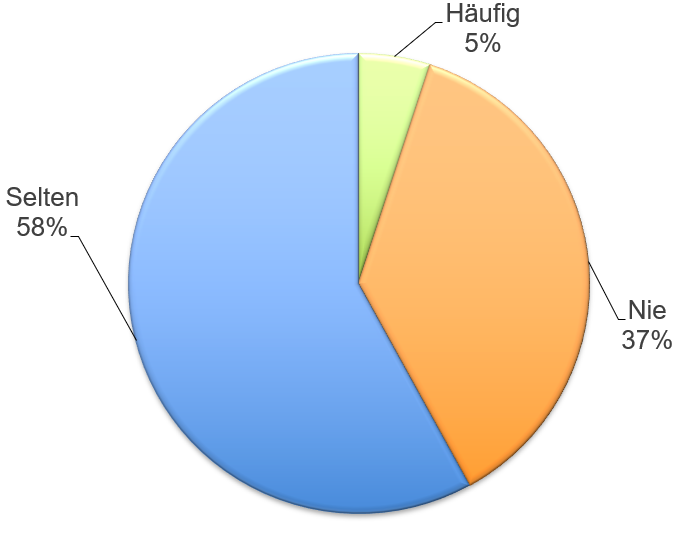
|
frequently |
rarely |
never |
|
|
Chronic pyelonephritis |
5% |
58% |
37% |
Acute pyelonephritis [ICPC-3 UD01; ICD-10 N10] presents with pain in the lumbar region, pressure and tenderness of the renal beds, and nausea with a greatly reduced general condition, with and without fever in children.
Co-treatment in the acute phase, in addition to antibiosis, may promote rapid recovery. However, these are isolated experiences when patients are already under homeopathic treatment beforehand.
Chronic pyelonephritis is a rare treatment concern in practice. In the ICD10 classified under ICD-10 N11.- mostly in combination with malformations or neurogenic bladder dysfunction and as a result of frequent acute inflammation.
Anamnestic associations with frequent episodes of acute UTI with prolonged courses, vesicoureteral reflux in childhood, and neurogenic voiding dysfunction, e.g., in multiple sclerosis, are considered seminal.
Other urological diseases
Single mentions: Nephrolithiasis [ICPC-3 UD67; ICD-10 N20.0], glomerulonephritis [ICPC-3 UD65;ICD-10 N00], prostatic hyperplasia benign [ICPC-3 GD70;ICD-10 N40], other diseases of the urinary organs [ICPC-3 UD66; ICD-10 N39] such as renal insufficiency renal cysts, cystic kidney are in homeopathic practice mostly incidental findings resp. Therefore, they were not statistically recorded in the survey.
Pregnancy Assistance
The majority of all cases in the outpatient practice come to homeopathic assistance treatment when the woman and expectant mother do not feel sufficiently understood and cared for with their fears and anxieties, sleep disturbances or also with pregnancy nausea, discharge, back pain or also changes in self-perception.
A mixture of individually different and often also biographically conditioned patterns of complaints is often found in the case admission, which are readily accessible to treatment. Hidden conflicts can also be found, e.g., settling into the new role, coping with changes in the partnership, complicated nutritional diet plans and ideas of life reorganization as a proxy for family stresses, and many more.
The most common treatment concerns
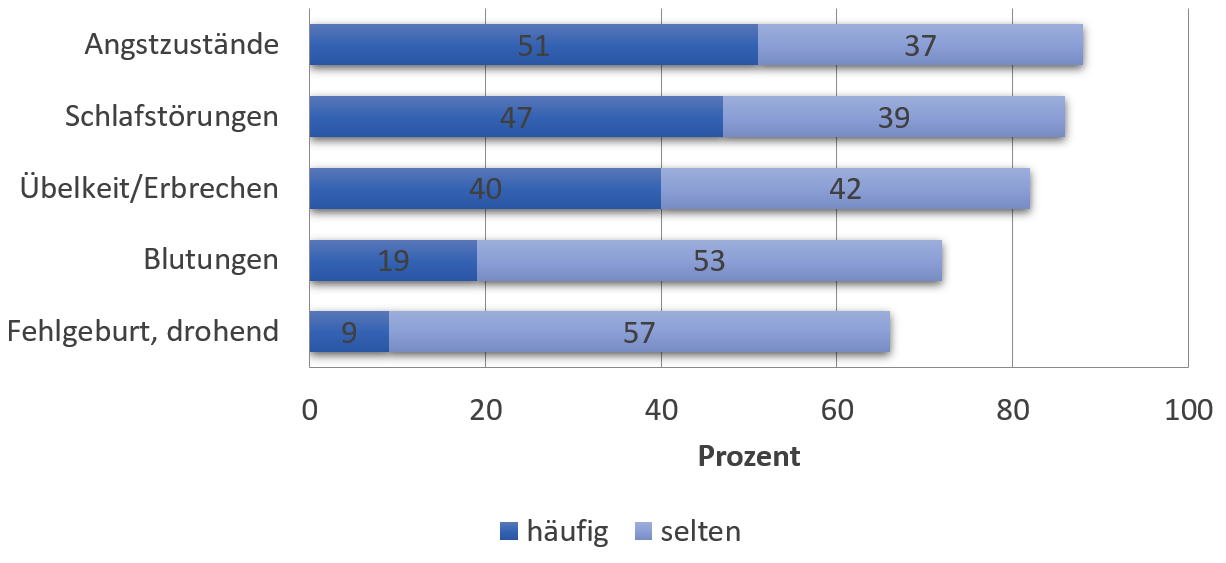
|
frequently |
rarely |
|
|
Anxiety |
51% (50,89%) |
37% (36,82%) |
|
Sleep disorders |
47% (46,54%) |
39% (39,38%) |
|
Nausea/vomiting during pregnancy |
40% (40,15%) |
42% (41,68%) |
Rare in homeopathic practice:
|
frequently |
rarely |
|
|
Bleeding |
19% (18,67%) |
53% (52,68%) |
|
Miscarriage, threatening |
9% (8,69%) |
57% (56,77%) |
Fears during pregnancy
Fears during pregnancy mostly refer to one's own external appearance due to physical changes [ICPC-3 AS92; ICD-10 R46.8] or to an excessive concern about the normal course with fear of birth, complications or malformations in the child [ICPC-3 WS91; ICD-10 Z71.1].
To be distinguished is a high-risk pregnancy [ICPC-3 WD71; ICD-10 Z35.-] with severe anemia, diabetes, an existing chronic disease that could affect the pregnancy, narrow pelvis, abnormal fetal position, placenta praevia, maldevelopment or too small fetus, toxicity of pregnancy in previous births, frequent miscarriages in the history, and others.
Sleep disorders during pregnancy
Sleep disorders [ICPC-3 PS06; ICD-10 G47.-] during pregnancy are a frequent counselling concern. In the majority of cases, these are acute stress reactions [ICPC-3 PS02; ICD-10 F43.0] resulting from the life situation. Organic connections have usually already been ruled out gynaecologically.
Unrecognised fears and a concealed rejection of the pregnancy itself should be investigated.
Nausea of Pregnancy
Hyperemesis gravidarum [ICPC-3 WS02; ICD-10 O21.-], the nausea / vomitting of pregnancy with morning accumulation is a frequent treatment concern with a constitutional background, which is well accessible to homeopathic treatment, where the differentiation of the acute symptoms is often not sufficient.
Rarer issues in pregnancy counselling: Bleeding during pregnancy - threat of miscarriage
Bleeding [ICPC-3 WS03 Bleeding in the first 20 weeks of pregnancy, WS04 - after the 20th week of pregnancy; ICD-10 O20.- Haemorrhage in early pregnancy, ICD-10 N93.- Other abnormal uterine or vaginal bleeding] includes vaginal bleeding.
Miscarriage, threatened [ICD-10 O20.0 Threatened abortion] is not clearly categorised in ICPC-3. This often involves excessive, too frequent and too strong contractions, usually between the 22nd and 30th week of pregnancy, also combined with weakness of the cervix with the risk of a shortened duration of pregnancy.
Treatment is usually only requested as an accompanying measure if a gynaecological diagnosis has already been made, even in the case of inpatient treatment. Homeopathic co-treatment depends on the individual circumstances and the consent of the clinic.
Postpartum conditions and breastfeeding phase
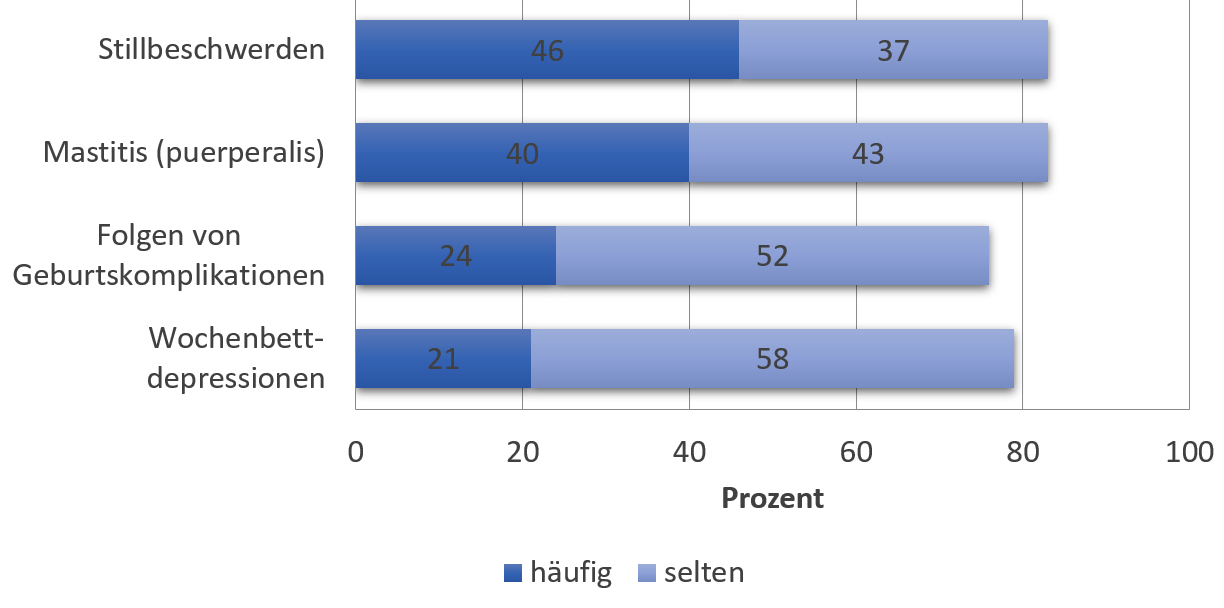
|
frequently |
rarely |
|
|
Breastfeeding complaints |
46% (45,78%) |
37% |
|
Mastitis (puerperal) |
40% (39,89%) |
43% (43,47%) |
|
Consequences of birth complications |
24% (24,29%) |
52% (51,91%) |
|
Postpartum depression |
21% (21,22%) |
58% (57,8%) |
From the onset of labour until the end of the postpartum flow, the mother and baby must be monitored by a doctor and/or midwife. With the consent of the midwife and at the mother's request, an alternative practitioner can provide supportive advice and recommend homeopathic remedies.[14]
Breastfeeding complaints and mastitis
Breastfeeding complaints include disorders of milk flow (agalactia, hypogalactia, galactorrhoea), difficulties with latching on, with the breastfeeding rhythm, inhibition of lactation, dysplastic nipples and others. [ICPC-3 WS06 Breast or lactation symptoms or complaints; ICD-10 O92.- Other diseases of the mamma [mammary gland] associated with gestation and lactation disorders]
Mastitis puerperale [ICPC-3 WD03; ICD-10 O91.-]: Pain Redness, swelling of the breast in the first breastfeeding phase
Breast complaints in the postpartum period [ICPC-3 WD84; ICD-10 O92.0 to O92.4]: localised pain, rhagades, heaviness. Hardening
Postpartum complaint complexes
Consequences of complicated delivery [ICPC-3 WD82 Live birth WD83 Stillbirth] include all consequences of risks and interventions, such as sectio, assisted delivery, postpartum placenta praevia injuries.
Young mothers also seek help in homeopathic practice during the postpartum recovery period from weakness, psychological stress, persistent pain, concern for the child, or grief because of the lost child.
[Classification: In ICD-10 there are the equivalents for ICPC-3 WD82 and ICPC-3 WD83: O42 Premature rupture of membranes, O45 Premature placental abruption, O60 to O71, O73, O75.0, O75.4 to O75.9, O81 to O82, Z37.1 to Z37.9, Z38.-].
Postpartum Depression
Postpartum depression [ICPC-3 PD12] is classified in ICPC-3 as a depressive episode, and in ICD-10 under F53 as mental abnormalities that develop in the first 6 weeks after delivery and lack evidence of an underlying mental disorder.
Often there is also a conflict with being a mother in itself, along with experienced assault by one's own mother or mother-in-law, which requires an expanded understanding of the present family dynamics in order to understand the depressive symptom pattern.
As an authorized user, you can download the complete package of all differential diagnostic considerations and AGV as a .zip file here.
References
The sources mentioned served as a basis for the creation of the survey for structuring the question blocks. They can also be found as source references at individual points in the overall document on the supply situation in homeopathic practice.
[1] Mader, F. H. & Riedl, B. (2018). Allgemeinmedizin und Praxis (8th ed./first edition 1993). Springer Verlag.
[2] Hopcroft, K. & Forte, V. (2013). Differenzialdiagnostische Tabellen – Symptome in der Allgemeinmedizin (1st ed.). Huber Publishers.
[3] Klimm, H.-D. & Peters-Klimm, F. (Eds.). (2018). Allgemeinmedizin (6th ed.). Georg Thieme Verlag.
[4] Lehrke, P. (1998). Impfkonzepte in der Homöopathie Edition Forschung: Eine Erhebung zum Impfverhalten homöopathischer Ärzte. Hippokrates Publishers.
[5] Impfpflicht versus informierte Entscheidung. (2019, May 2). German Network EBM. Retrieved May 18, 2022, from https://www.ebm-netzwerk.de/de/veroeffentlichungen/stellungnahmen-pressemitteilungen May 02, 2019).
[6] Lyons-Wyler, J., Thomas, P. (2021 Jan 22;18(3):936). Relative Incidence of Office Visits and Cumulative Rates of Billed Diagnoses Along the Axis of Vaccination. Int J Environ Res Public Health. doi: 10.3390/ijerph18030936.
[7] Hautärzte sehen Krätze auf dem Vormarsch. (2016, November 28). Physicians Journal. Retrieved May 18, 2022, from https://www.aerzteblatt.de/nachrichten/71688/Hautaerzte-sehen-Kraetze-auf-dem-Vormarsch
[8] Schultz-Zehden, W. & Bischof, F. (1986). Auge und Psychosomatik (1st ed.). Deutscher Ärzteverlag.
[9] Jobst, D. (2013). Facharztprüfung Allgemeinmedizin: in Fällen Fragen und Antworten (4th ed.). Urban & Fischer Verlag/Elsevier GmbH.
[10] Menopausal Hormone Therapy and Cancer Risk. (2015, February 13). American Cancer Society. Retrieved June 1, 2022, from https://www.cancer.org/cancer/cancer-causes/medical-treatments/menopausal-hormone-replacement-therapy-and-cancer-risk.html
[11] Günthert, E. A. (2013). Psychosomatische Urologie: Leitfaden für die Praxis-Schriftenreihe der Thure von Uexküll-Akademie für Integrierte Medizin (2nd ed.). Schattauer.
[12] WONCA International Classification Committee, Mally, T., Committee, W. I. C., Tönies, H., Zehnder, K., Fischer, G. & Glehr, R. (2001). Internationale Klassifizierung der medizinischen Primärversorgung ICPC-2. Springer Publishing.
[13] Spinks A., Glasziou P.P., Del Mar C. B. (2021). Antibiotics for treatment of sore throat in children and adults. Cochrane Database Syst Rev. 2021 Dec 9;12(12):CD000023. https://doi.org/10.1002/14651858.CD000023.pub5
[14] Schweitzer, R., & Schröder, M. (2018). Die Heilpraktiker-Akademie. Gesetzeskunde, Notfallmedizin und Pharmakologie: Mit Zugang zur Medizinwelt. p.48.
[15] Galic, T. & Schnellrieder, H. (2018). Heilpraktiker mit Fachrichtung Homöopathie – ein Laienclub ohne Bildung? Homöopathie KONKRET. 11.Jahrgang, 12/2018, Heft 4. S.13-20.
[16] International Classification of Primary Care - 3rd Revision. Retrieved 11.1.2025 from https://www.icpc-3.info/
[17] BFARM - ICD-10-GM Version 2025. Retrieved 11.1.2025 from https://klassifikationen.bfarm.de/icd-10-gm/kode-suche/htmlgm2025/index.htm